… or a teaser for posts on Friday and Saturday to be released on Monday and Tuesday and Wednesday. All photos were masterfully shot by the amazing PIFduo, Katja Goljat and Matjaž Rušt.
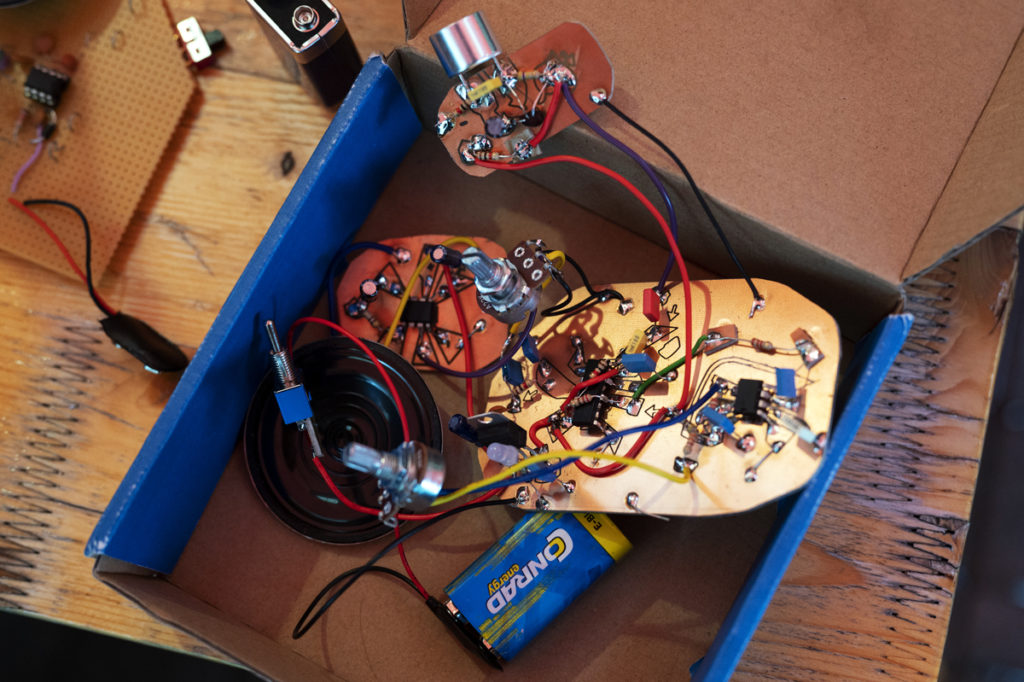
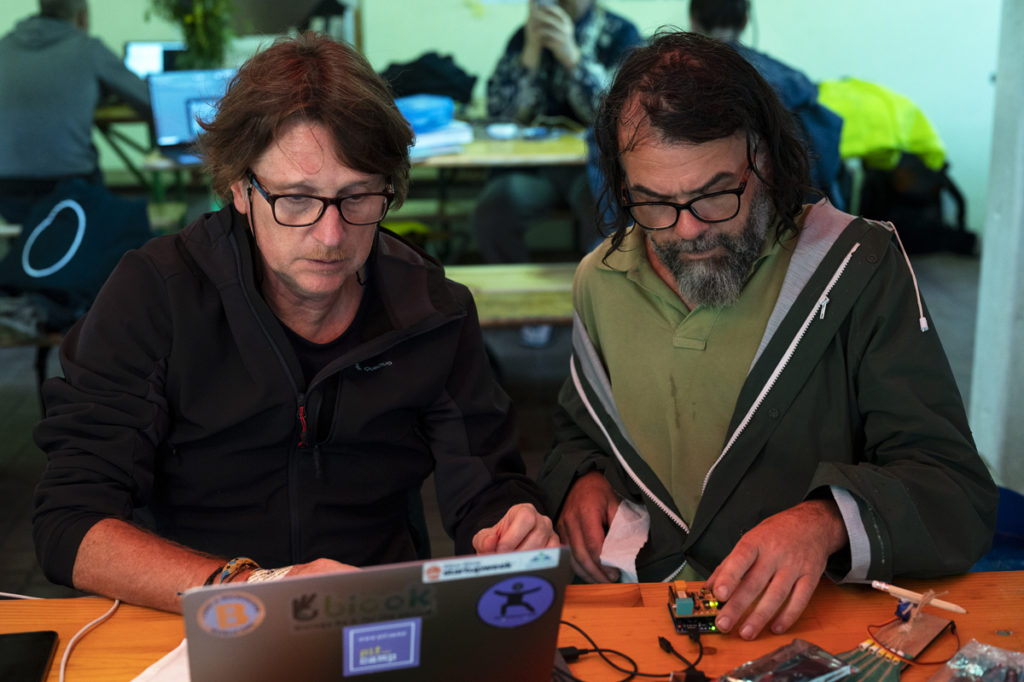
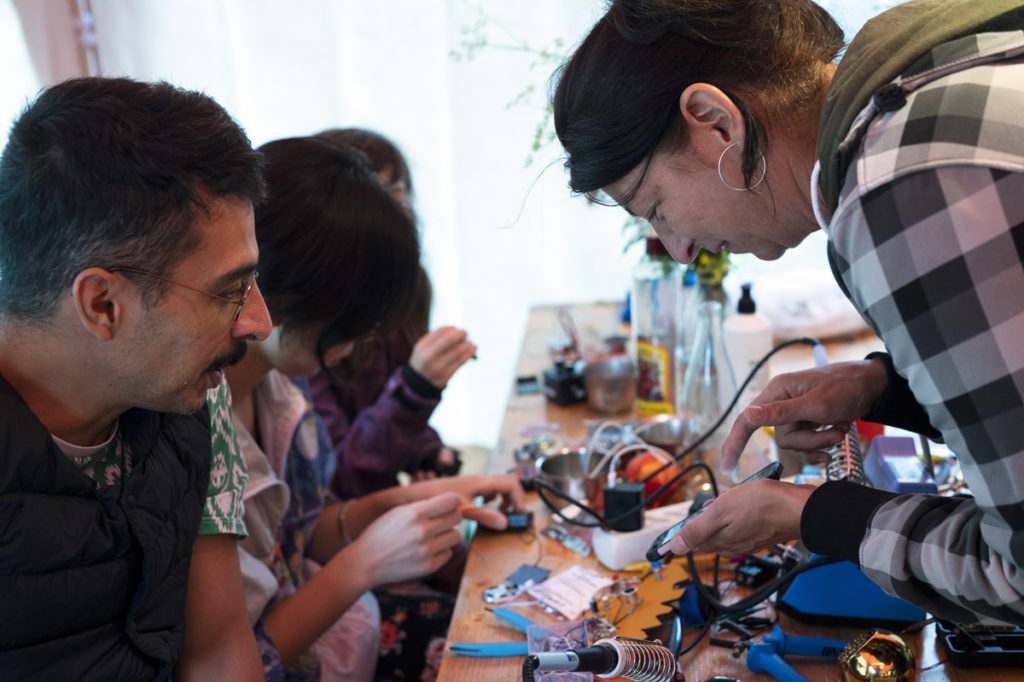


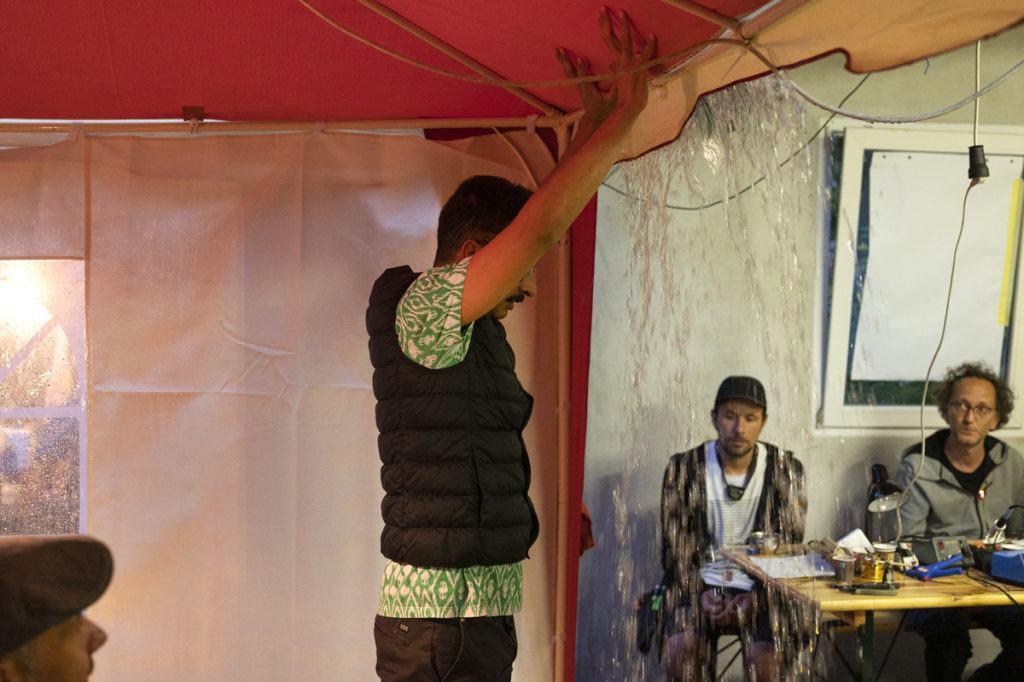

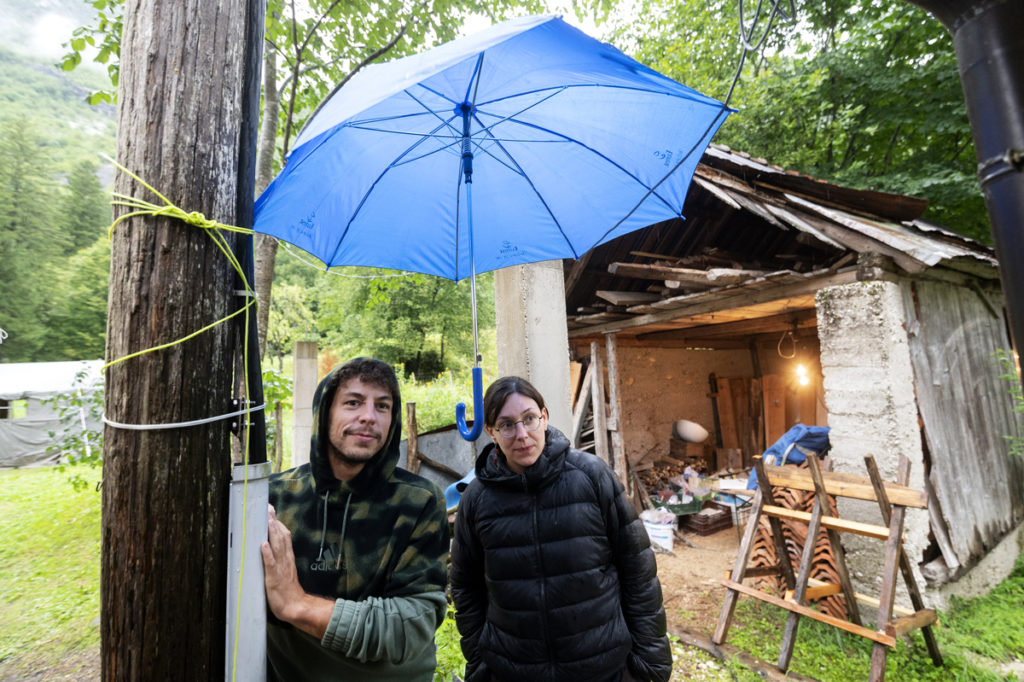
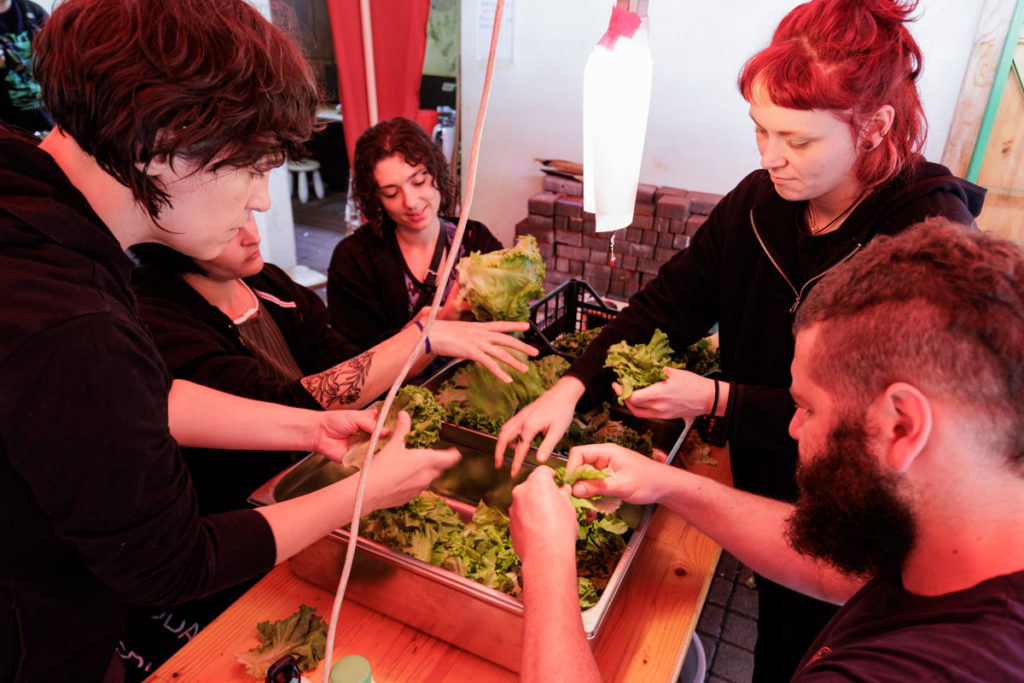
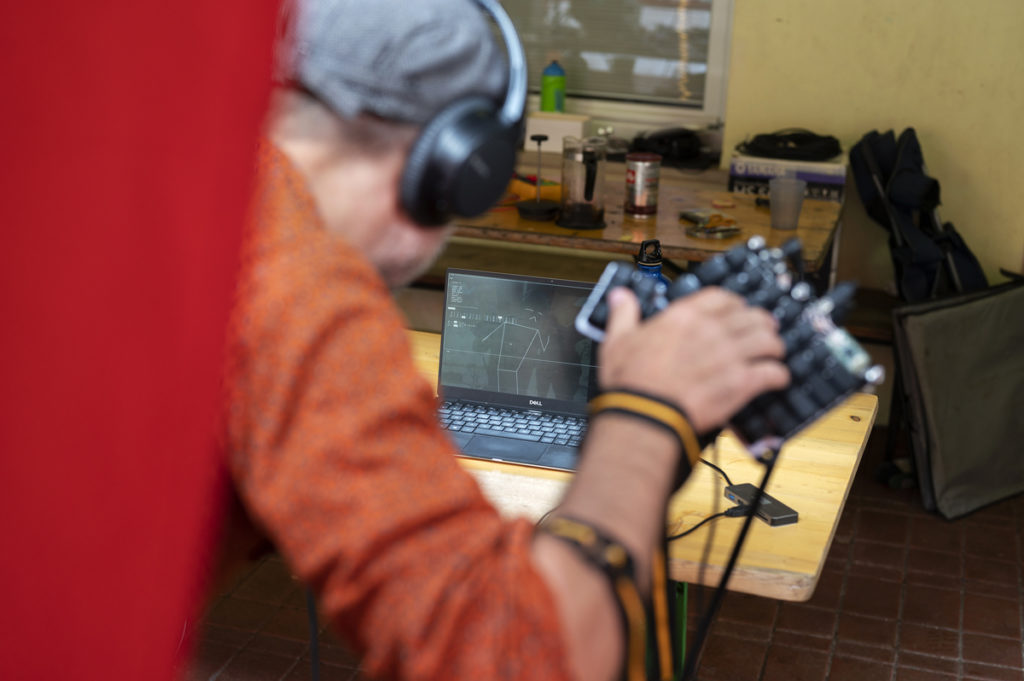
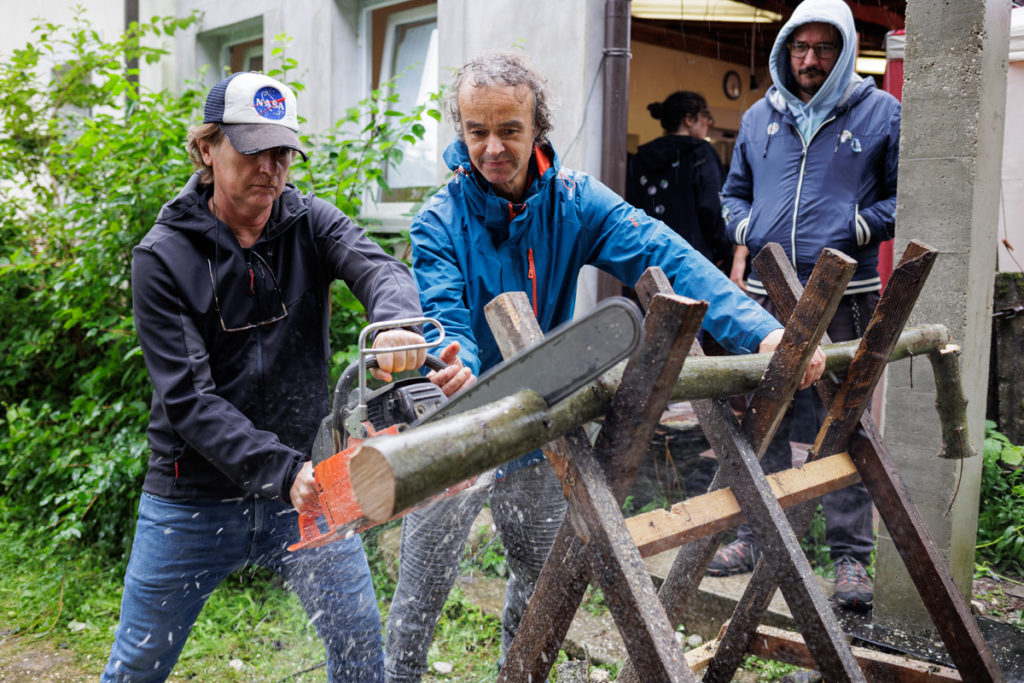
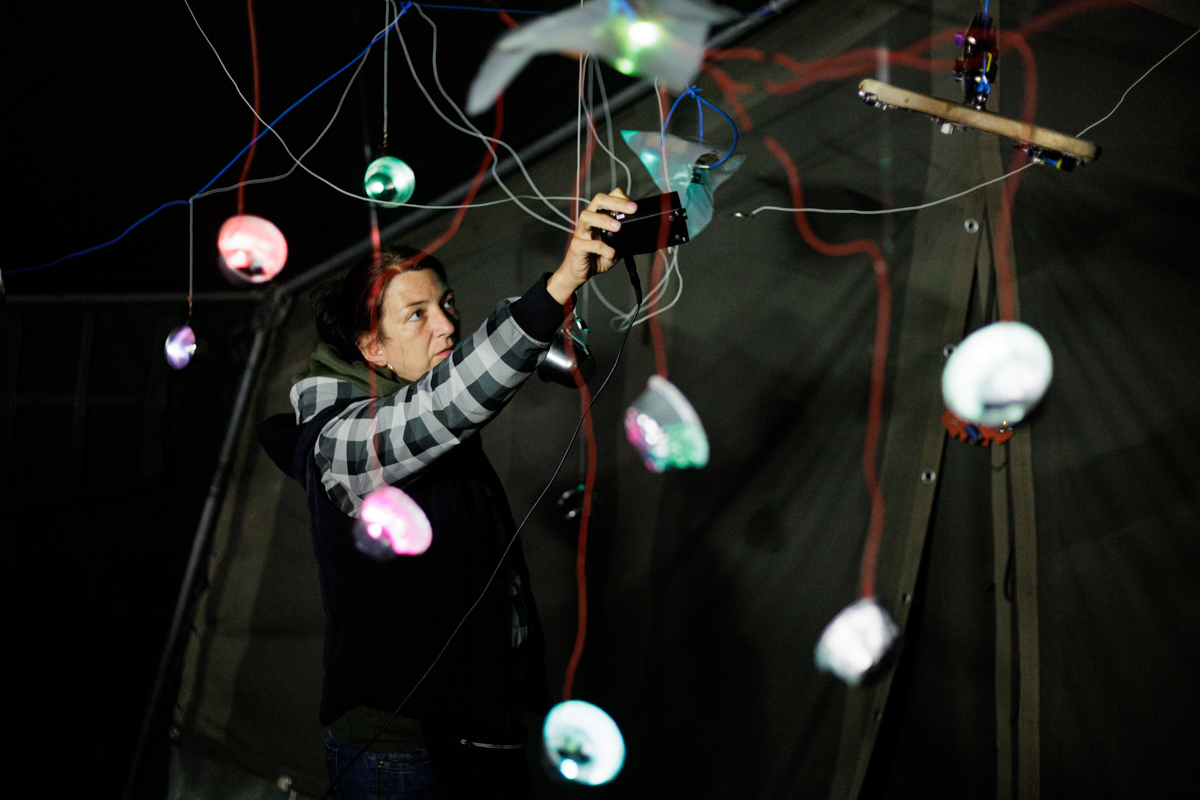
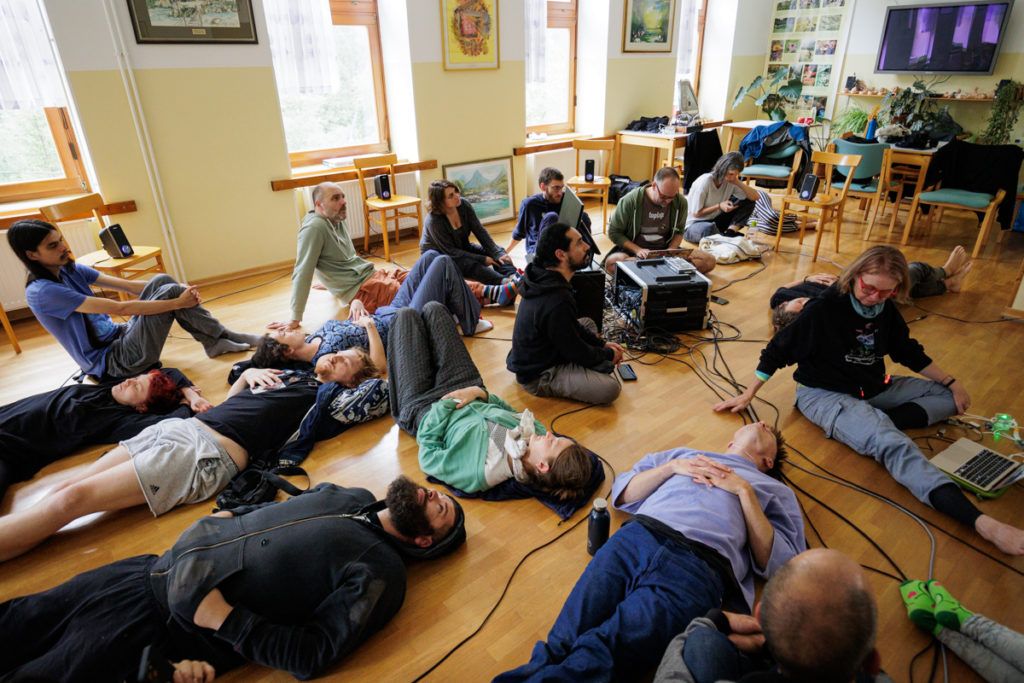
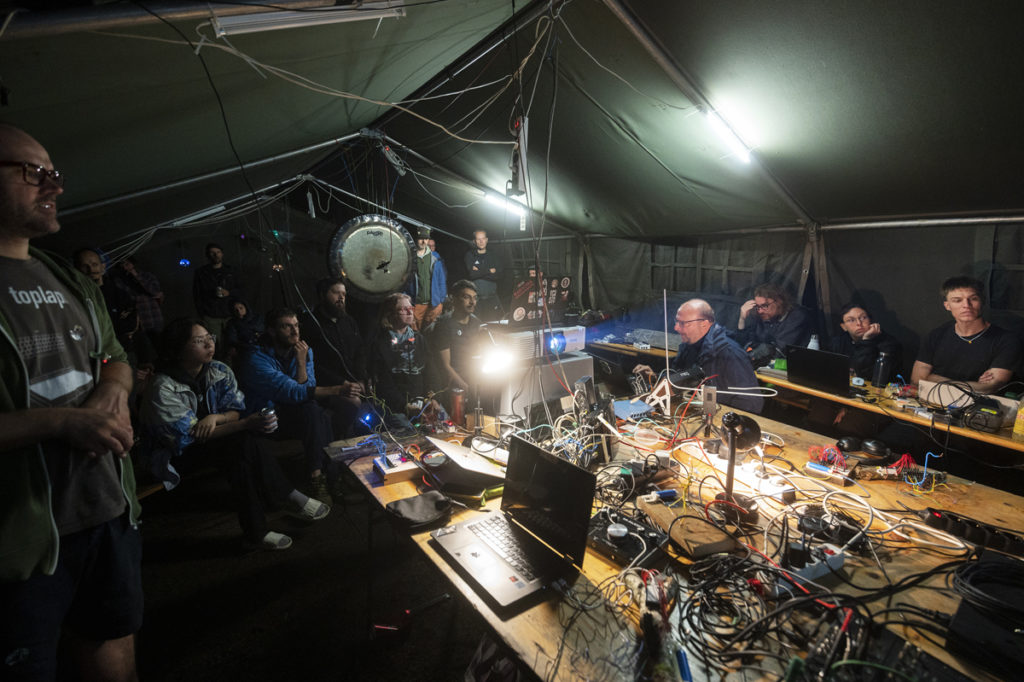
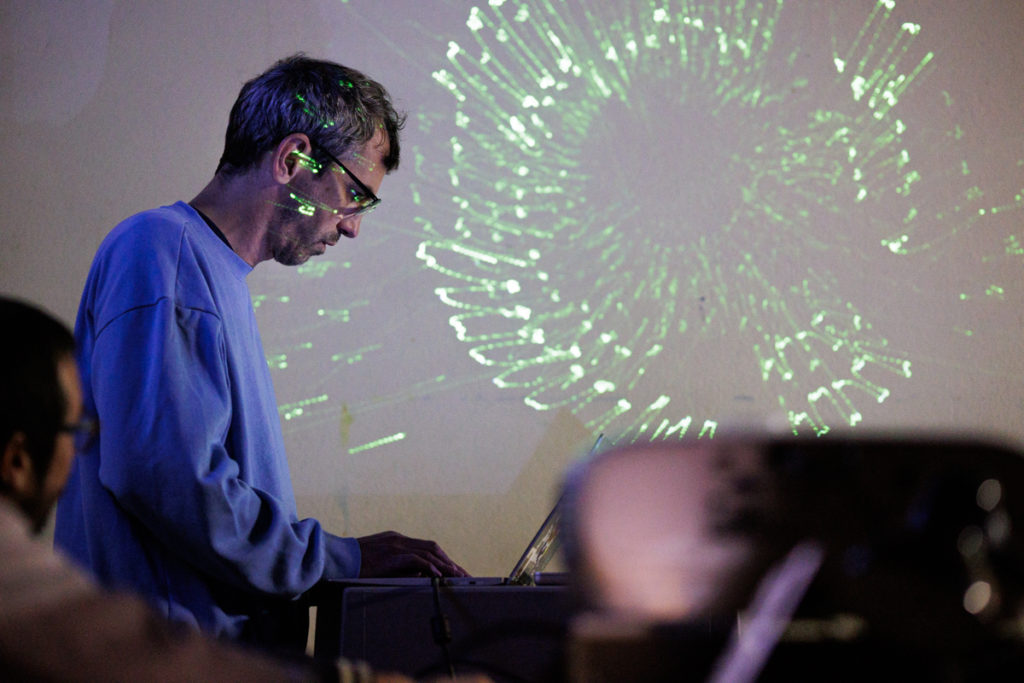
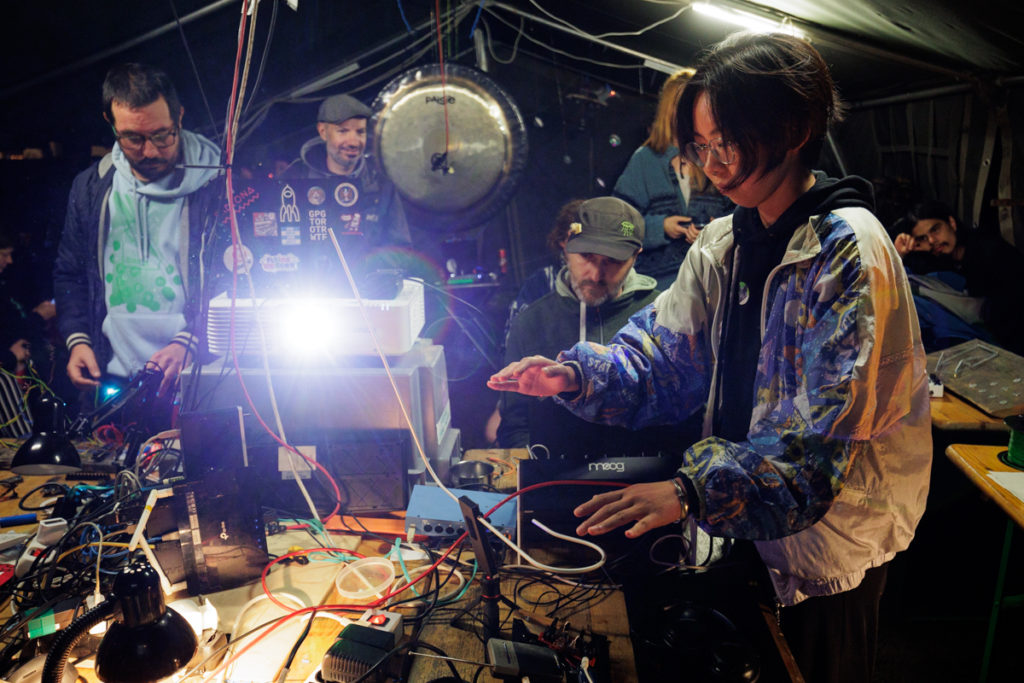
As you might have guessed from the title of this post, Thursday’s timetable was filled with workshops. Even though we really try hard to deliver news from PIFcamp on time, we are experiencing a minor setback, which is as much due to the fact there was a lot going on as it is to the gargantuan amounts of rain yesterday. There’s only so many dry working spaces when the PIFlake starts to form. However, this did not completely spoil the participants’ plans for the workshops. Shortly after breakfast, the first in the series of Touch Network workshops took place – Meta’s brooches and other decorations making workshop with LEDs. Also, one of the most popular PIFworkshops ever.
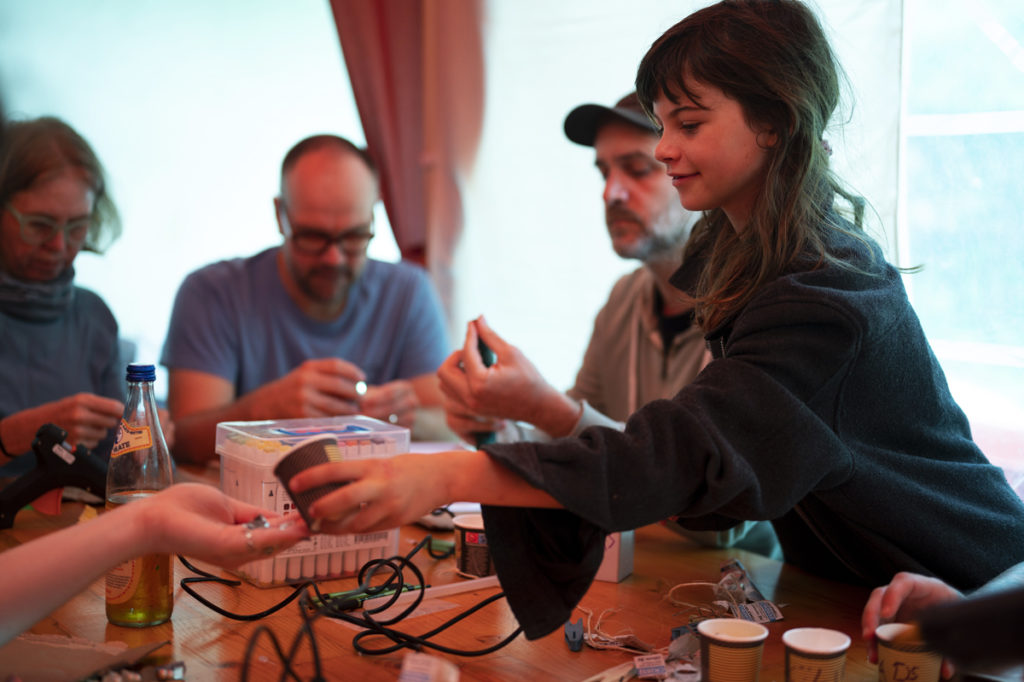
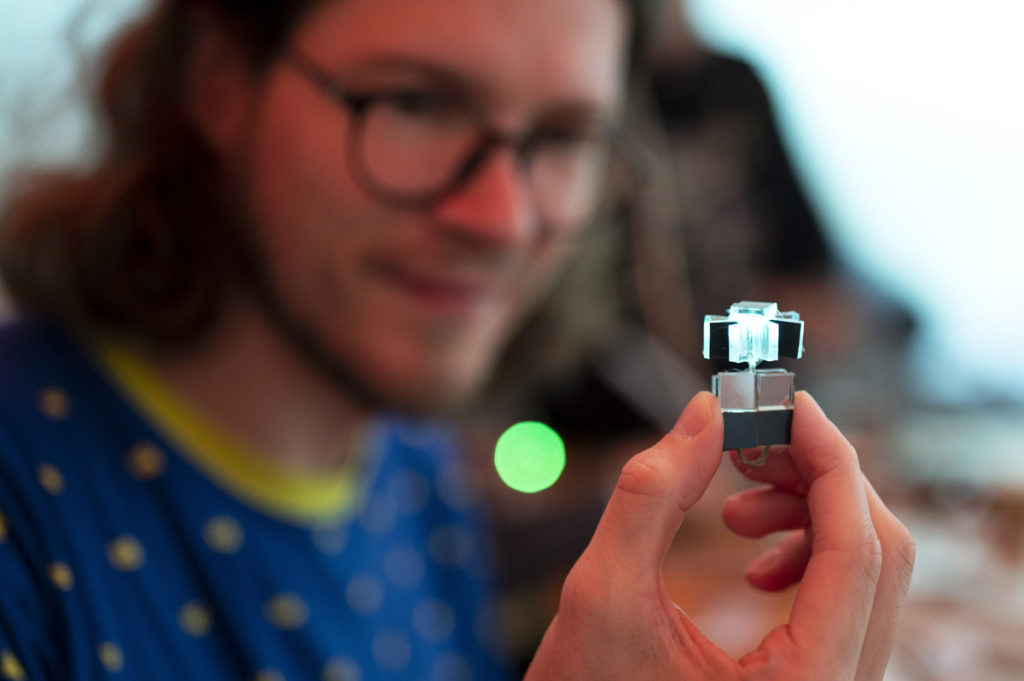
Meanwhile, Rob was in the tent preparing the presentation of the second workshop in the Touch Networks series, a workshop on making experimental musical instruments. After an introductory tech explanation, the participants went on a quest to find suitable bases for their instruments. Once they were satisfied with their findings, they started to upgrade the planks and logs into touch-sensitive musical instruments that send messages to Rob’s SuperCollider via the OSC protocol.
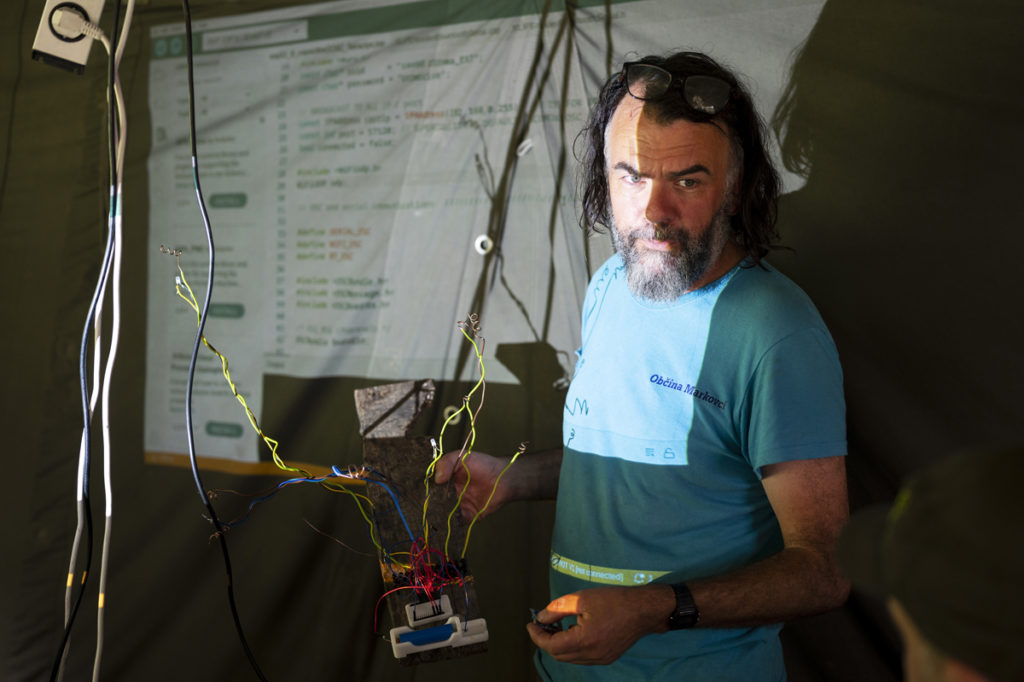
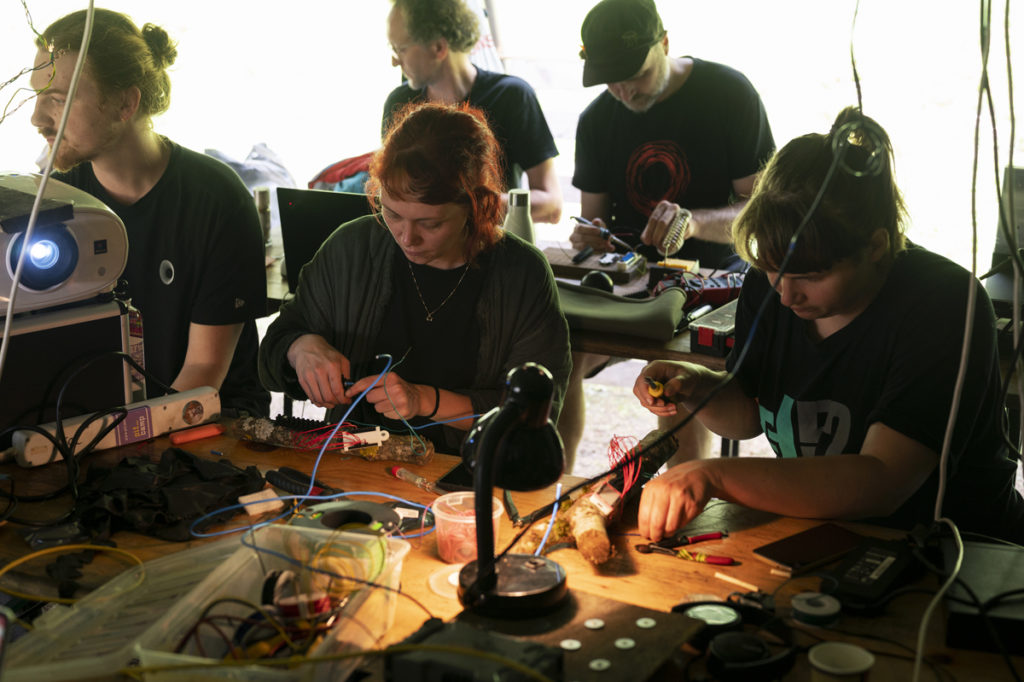
Simultaneously, the Instant Party workshop by Lina Bautista was taking place on the terrace. She introduced the participants to live coded music, explained the core principles of live coding and talked about the Tidal Cycles environment, which is one of the most popular tools among musician-coders. The practical part of the workshop followed. Participants experimented with live coding in MiniTidal and (for an instant) experienced collaborative coding using Estuary, a browser-based environment. As Alicia enthusiastically explained, the best feature of this collaborative coding tool is that it synchronizes the timing of all the participants, making it the ideal solution for remote participatory coding.
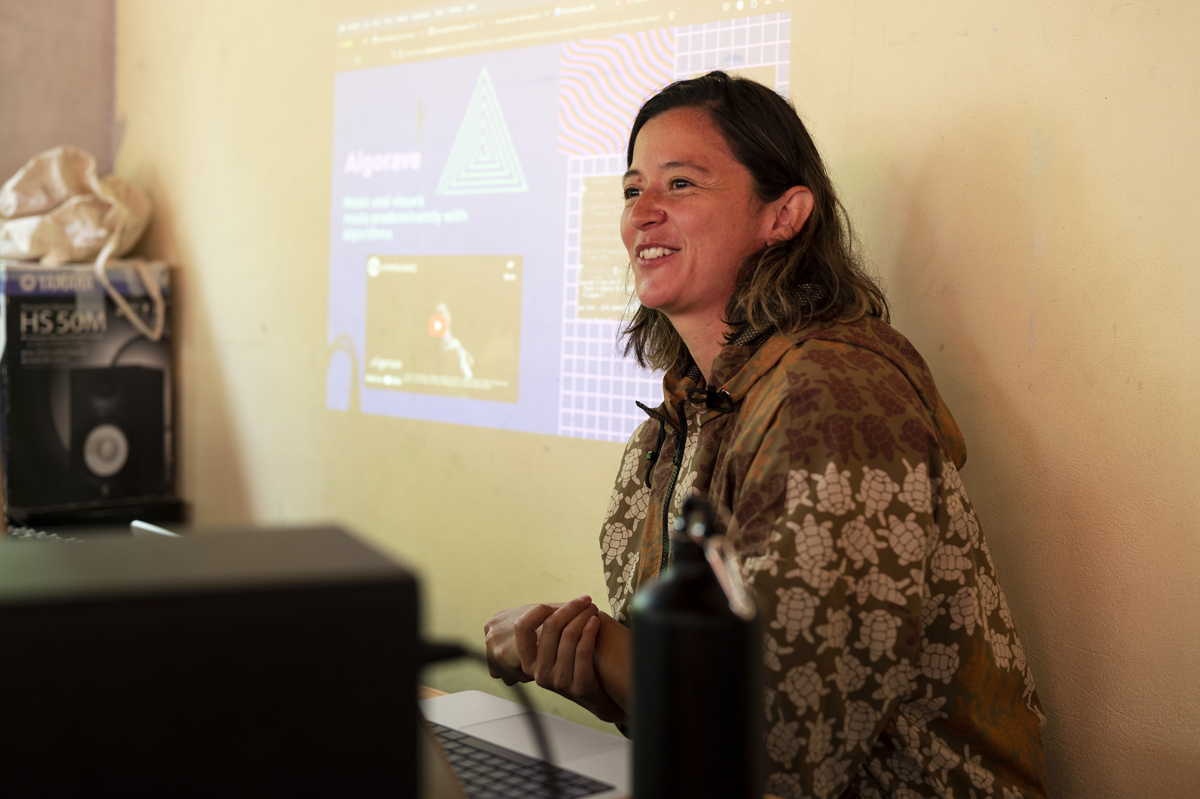
We also talked to one of the attendees, Julia, who had a great time during Lina’s workshop, and particularly remembered her saying that the whole point of live coding music is to have fun. She says that the workshop lived up to its name as it offered instant fun. On the spot, we also caught Lina’s excellent explanation of another core principle of live coding – it’s not just about sharing the screen (to quote one of the points of the manifesto), but about sharing in the broadest sense. By giving listeners or viewers a behind the scenes insight into the process, we allow them to copy the code and play our song or set themselves.
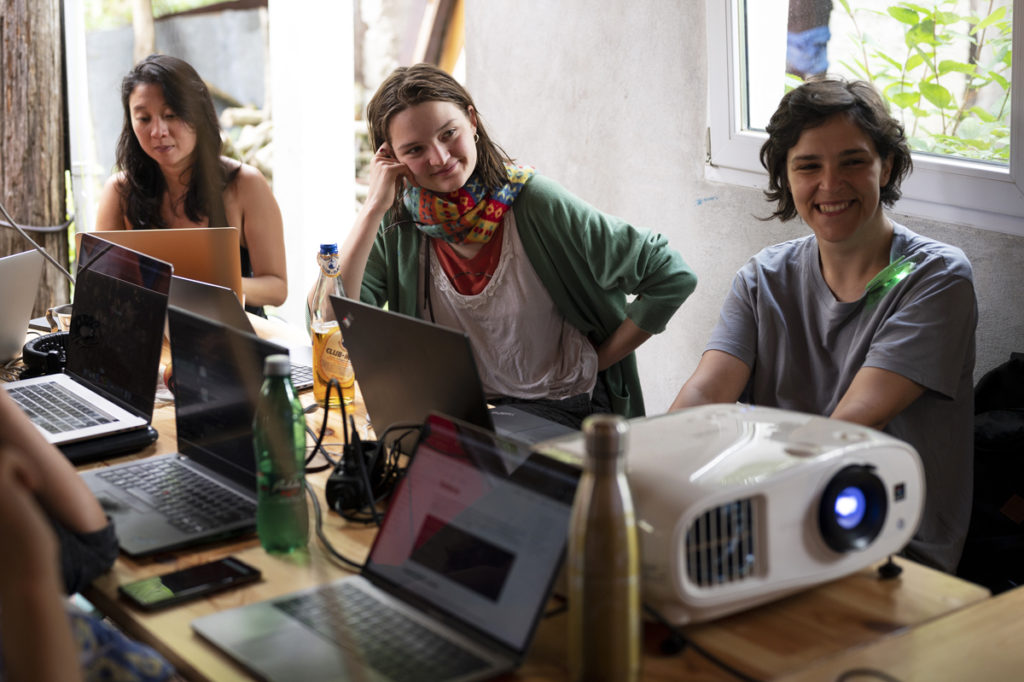
Under the tent, Rob’s workshop was gradually joined by a workshop by the Oscilloscope Music duo, about whom we have already written extensively in the PIFwednesday post. As expected after their amazing AV show on Wednesday, their workshop attracted quite an audience. The participants first learned the basics of safely handling lasers, familiarized themselves with Hansi’s and Chris’s set-up and software, and then tried their hand at laser visualizations.
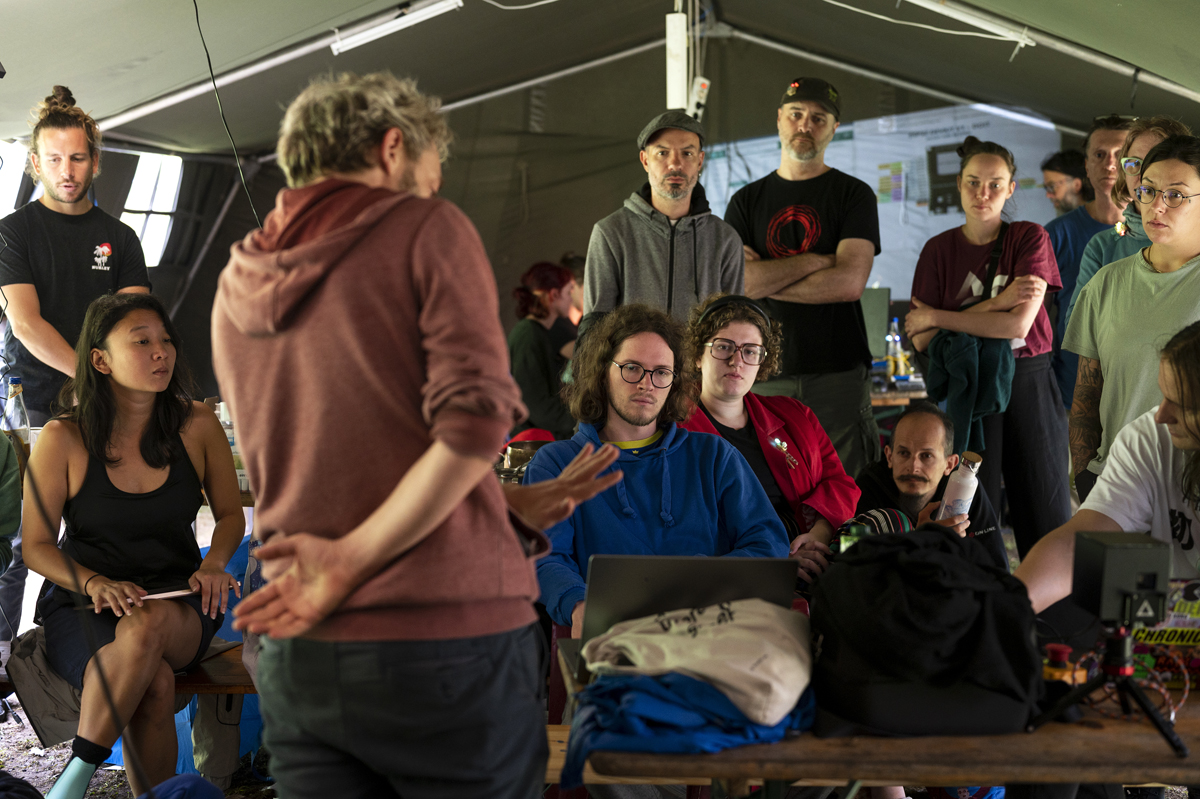
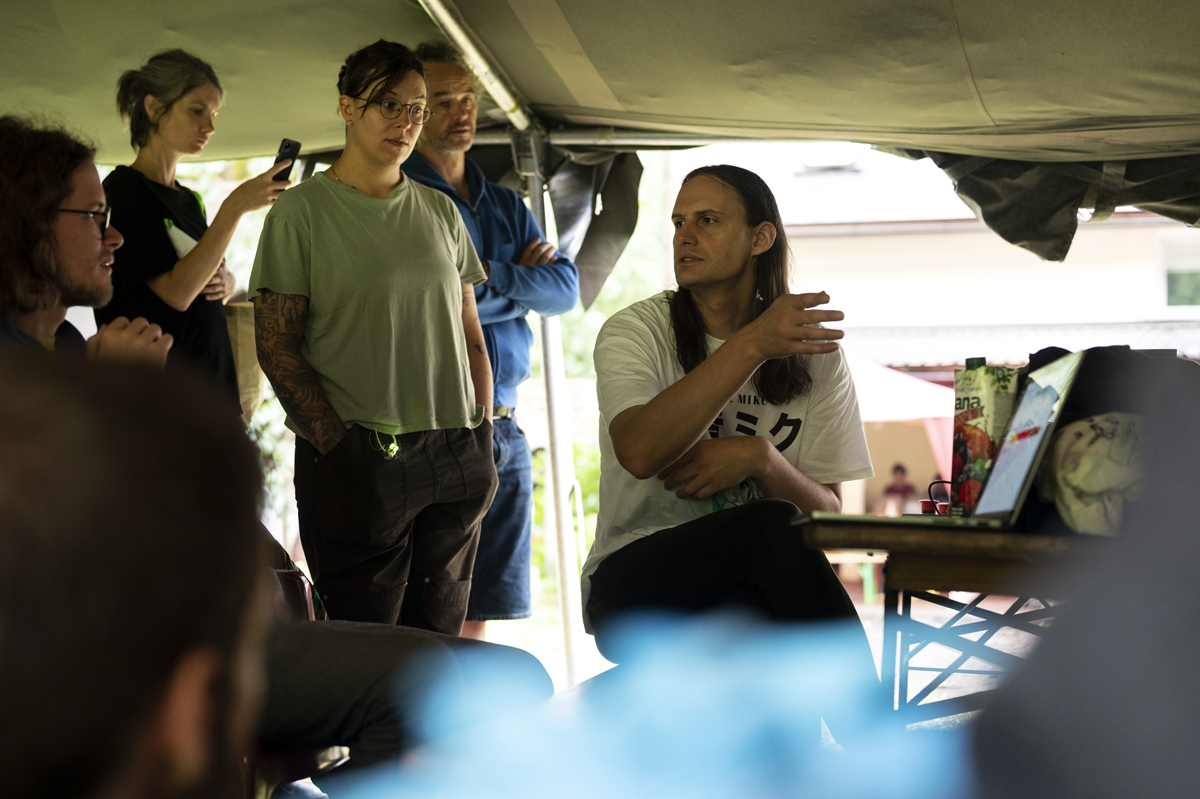
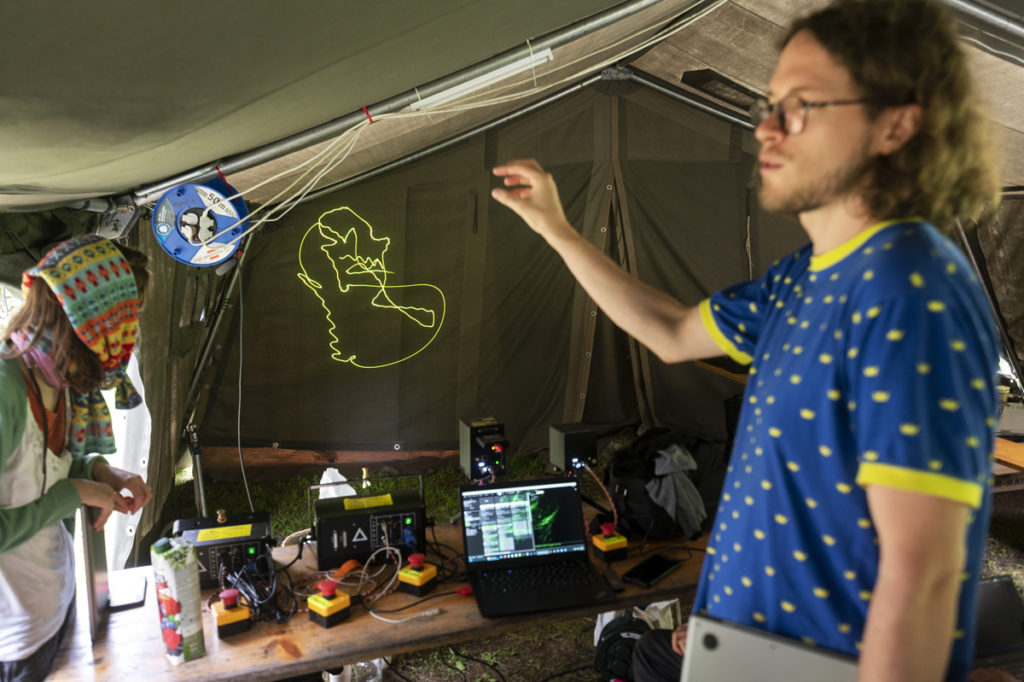
After lunch, a group of anything-food-related enthusiasts gathered at the other side of the PIFcamp for coffee and beetroot cake. Ahac welcomed them in his cosy little corner and invited them to share memories of Dario Cortese, who “really connected PIFcamp with nature”, as our host so aptly put it. They shared stories about this forager and explorer of fermentation, edible wild plants and the surrounding wilderness. If there is one common point among all the stories, it is the fact that everyone who knew him misses Dario. Unfortunately, yours truly had to leave the PIFood corner, and will report on the conversations that took place later in one of our future post.
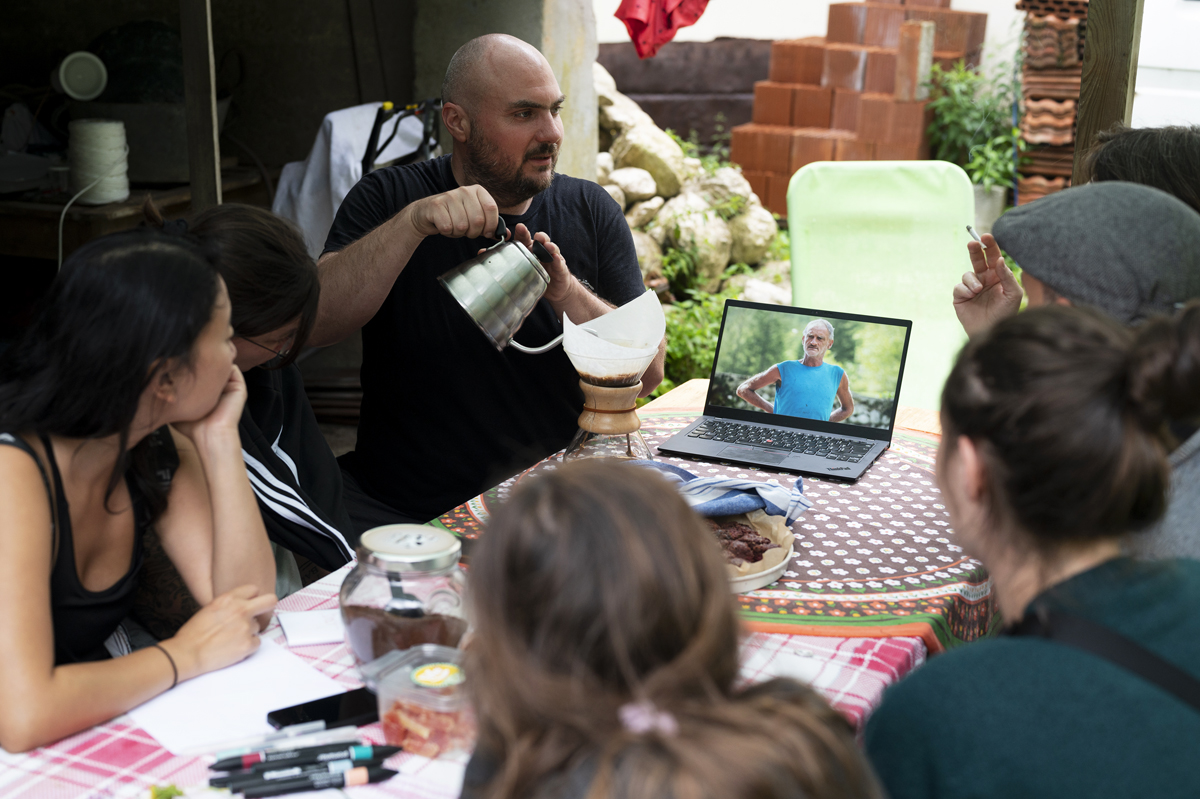
Although it may seem that the PIFlars were unable to progress with their PIFprojects due to the abundance of workshops and rainfall, we can immediately reassure you that this was not the case. If life gives PIFlars the rain, they will come up with a high-tech solution and get on with the job. One of our personal favourites has to be Jelissa’s laptop cover. As often happens at PIFcamp, she didn’t need this solution to move forward with her PIFproject. She teamed up with the artistic duo Swamp_Matter, Eva and Ana Laura, and she was happy to share her coding skills with them. One of the project team members who (like Jelissa) has organically become part of their artistic exploration is Jure, but more on that in the report from Saturday’s presentations. Hint: you’ll be reading about dancing stones.
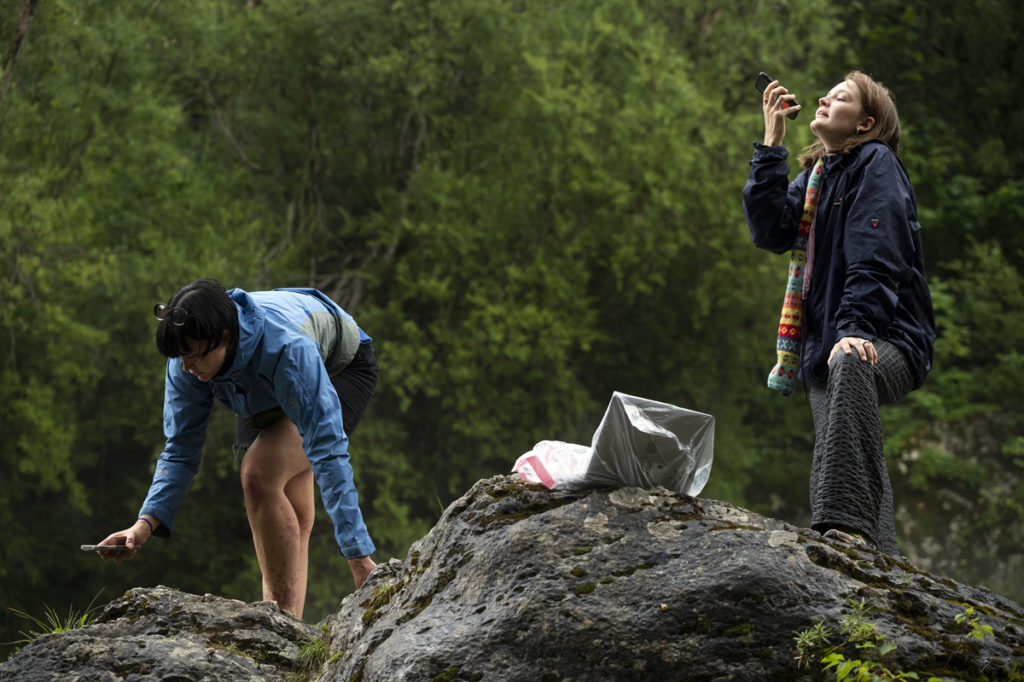
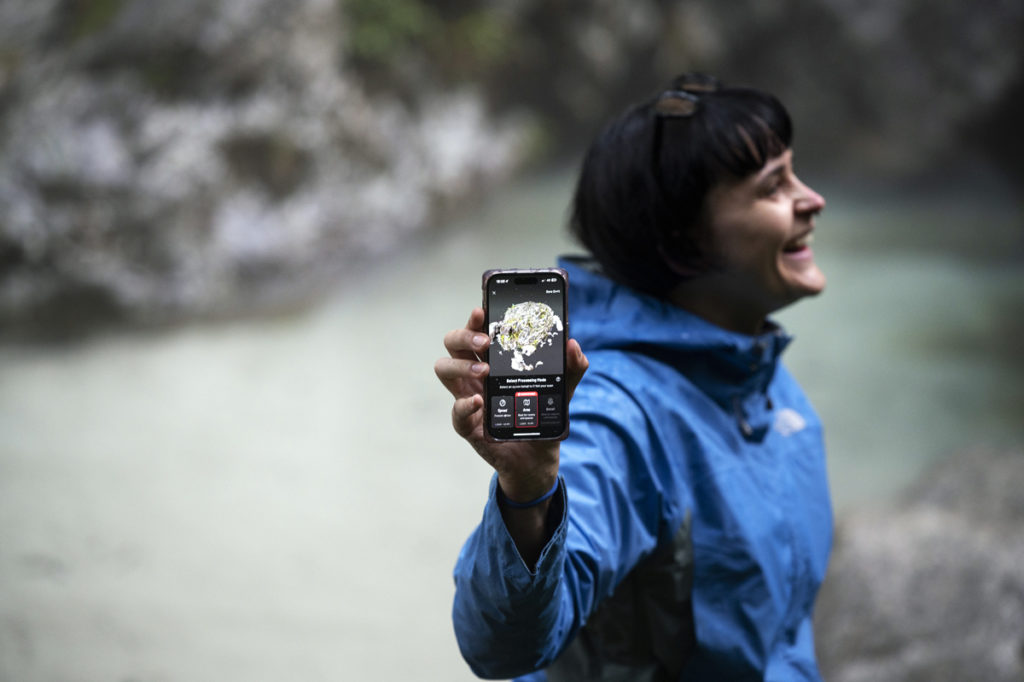
In the evening, the live coder community continued working on their PIFproject of infecting the participants with this artistic practice. Blaž organized a live coding workshop in the Hydra environment, which you may remember from last year’s PIFlog. He was clearly successful in this effort, since all the workshop participants later showed off their newfound knowledge at the From Scratch PIFevent, where they visualized the music of participants from Lina’s workshop and the seasoned live coders.
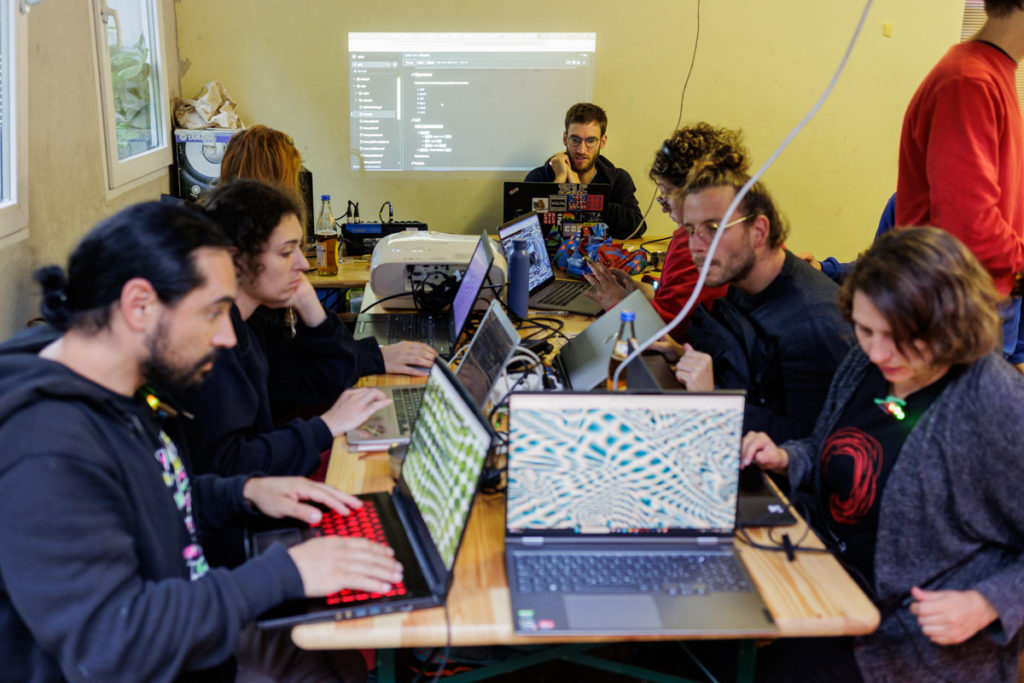
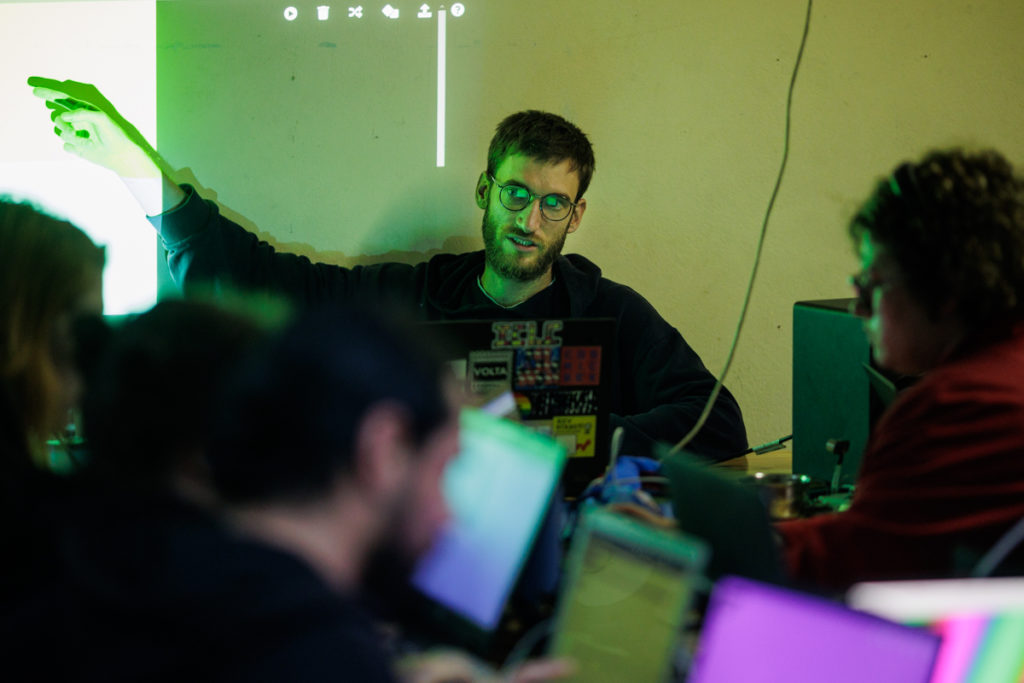
The evening slowly faded into night. Since it’s late, and your reporter has packing and tidying up to do tomorrow, she’ll try to summarize the events in a concise sequence of simple sentences and words, followed by a series of photos: From Scratch with 15 performers, Ewen Chardronnet’s amazing set and a b2b with Blaž, community bonding, a cocktail party, a fierce tarot fight, an epic battle with the level and the perimeter of the PIFlake. Good night!

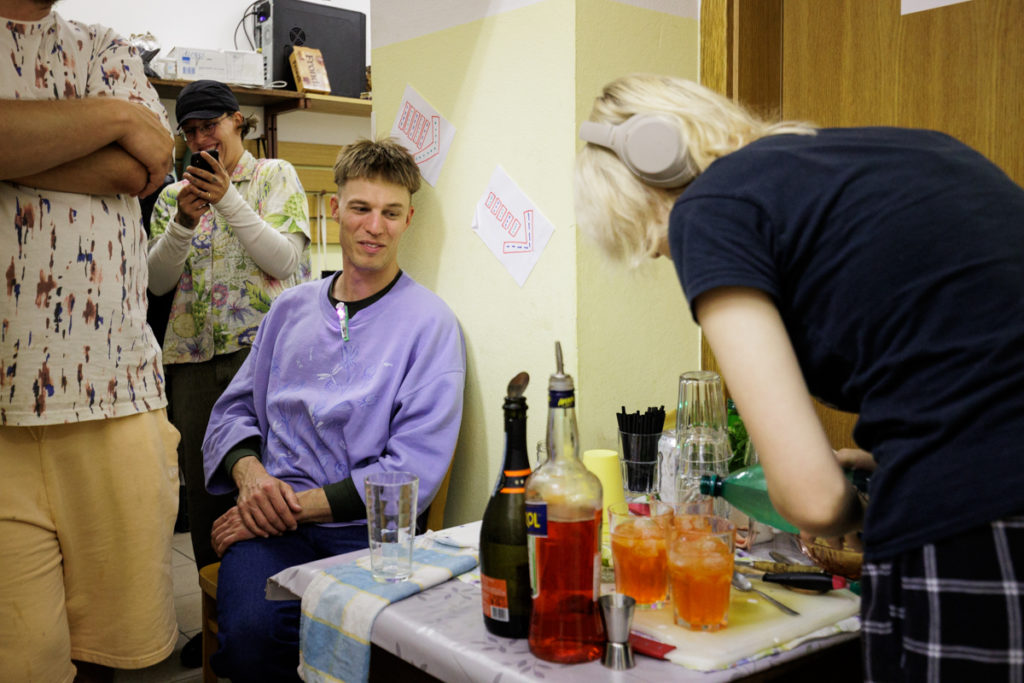
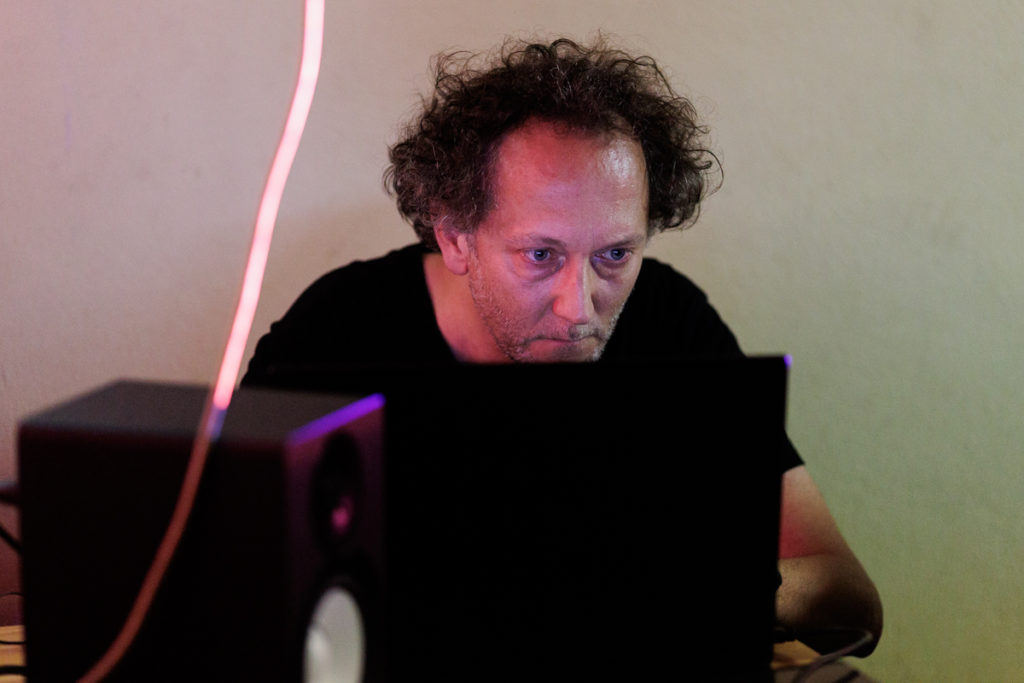
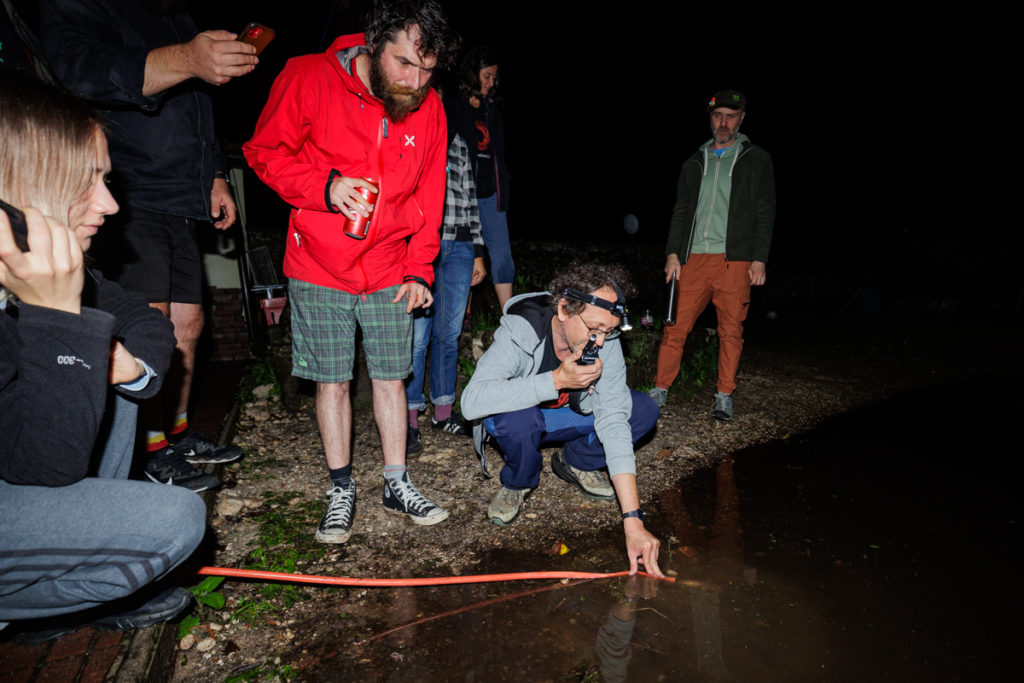
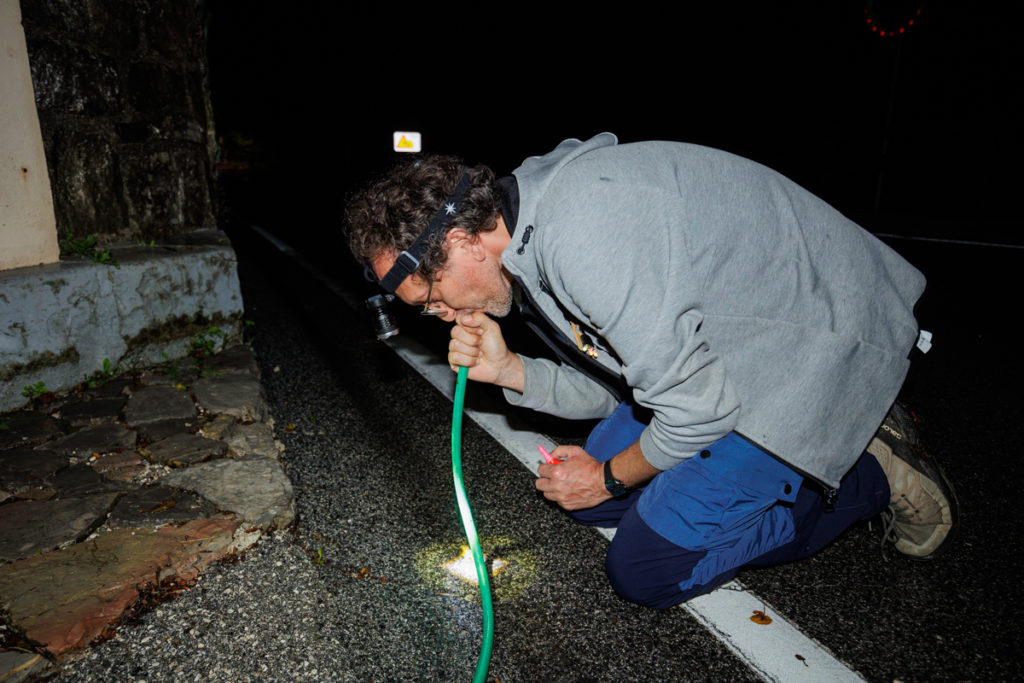
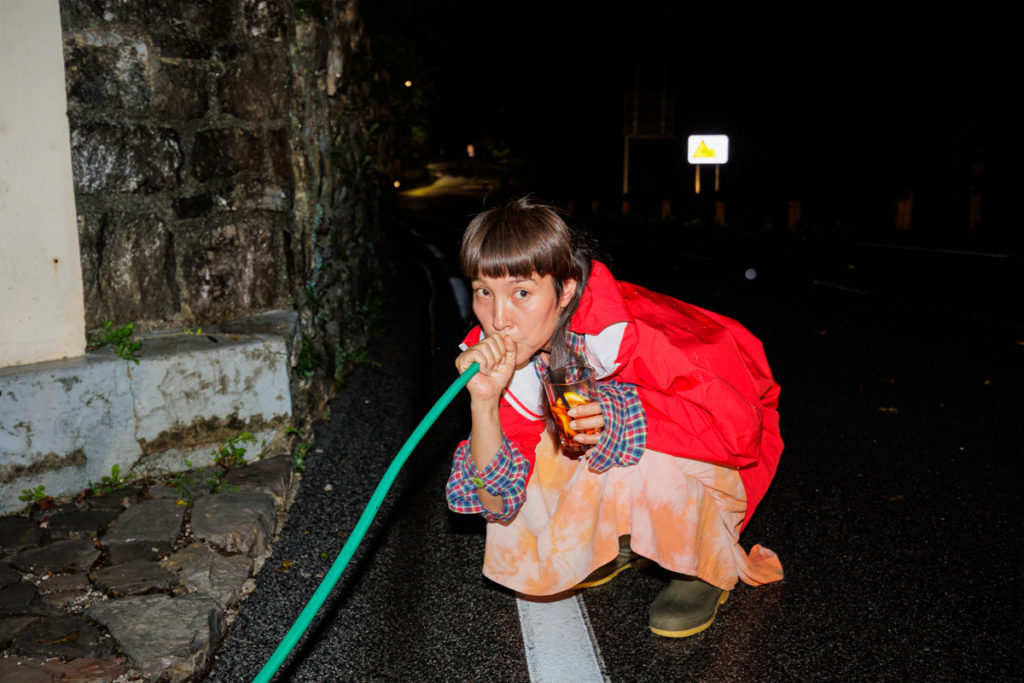

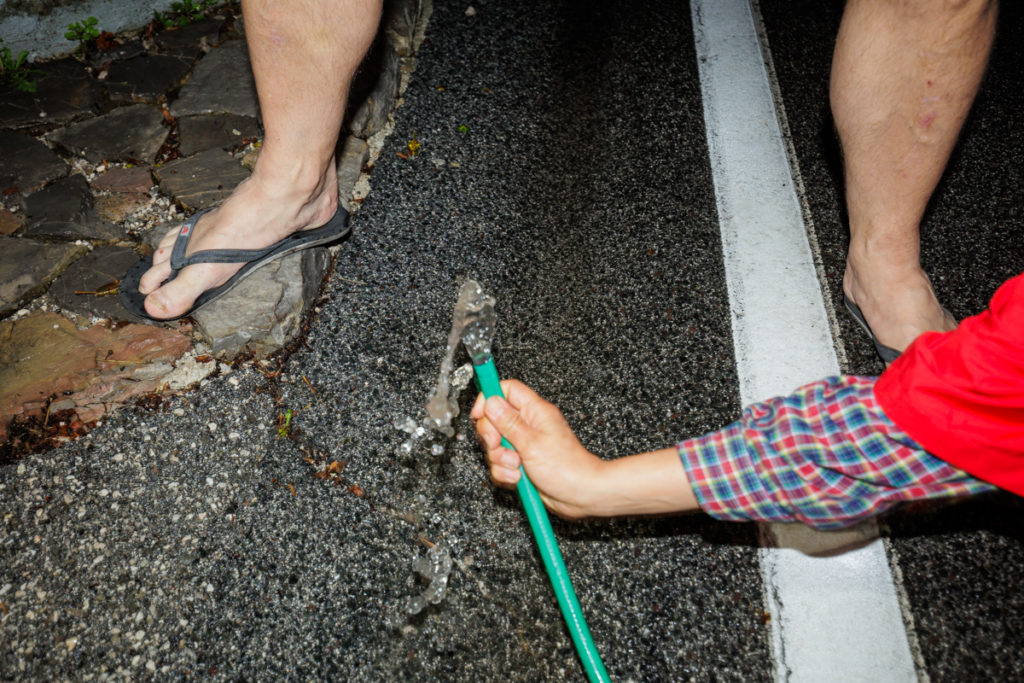
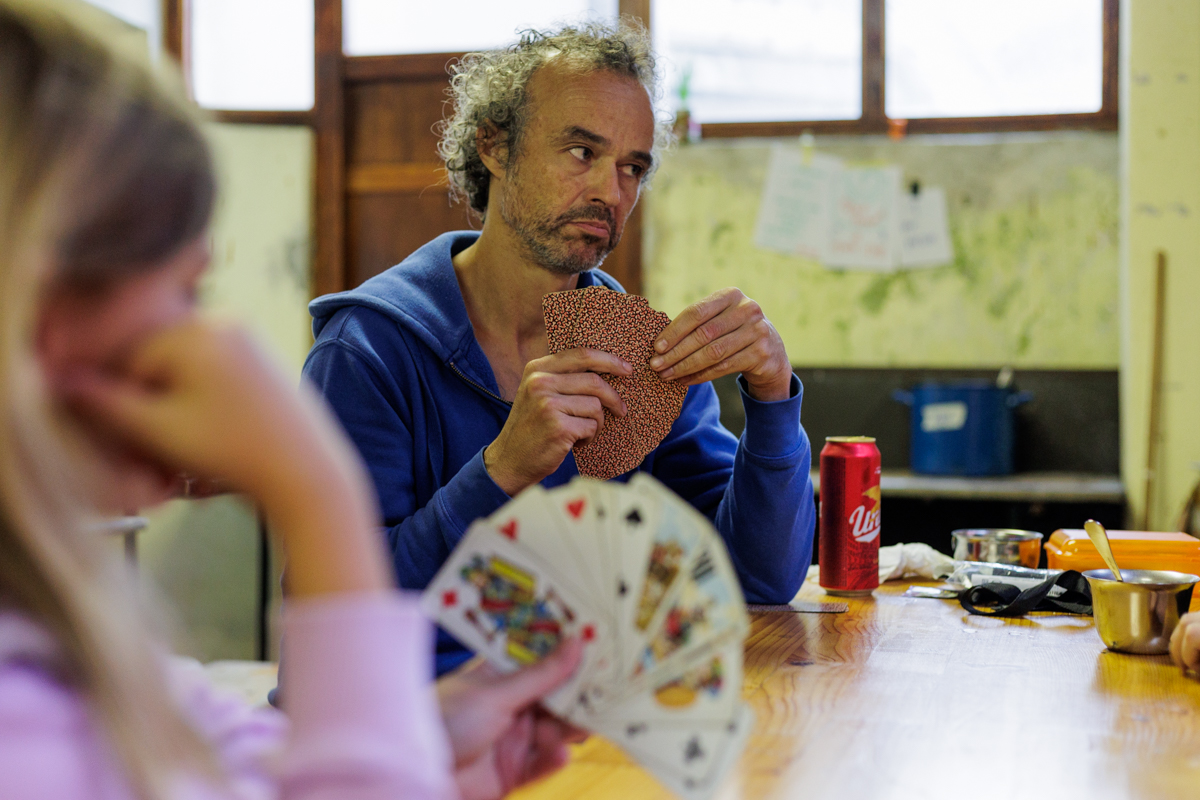
Epic PIFbattles. Photo: Katja Goljat, Matjaž Rušt
Since one-woman-blog-team hasn’t found the words yet to describe yesterday’s epic PIFday, here comes a photo dump (and two captions). More words tomorrow!
Traditionally, the first part of Wednesday at the PIFcamp is reserved for the hike to Krn Lake. Getting up at 6:00 is not the most popular activity, but every year, a fair number of PIFlars choose to participate – our favourite breakfast team, who open their sandwich shop on Tuesday evening for the occasion, reported 12 orders. Hikers were led by Jaka from Ekologi brez meja (Ecologists Without Borders), who is also in charge of the waste management at this year’s PIFcamp, keeping a watchful eye on (and weighing) the amount of different types of waste. Based on the data collected, he will propose guidelines for future improvements.
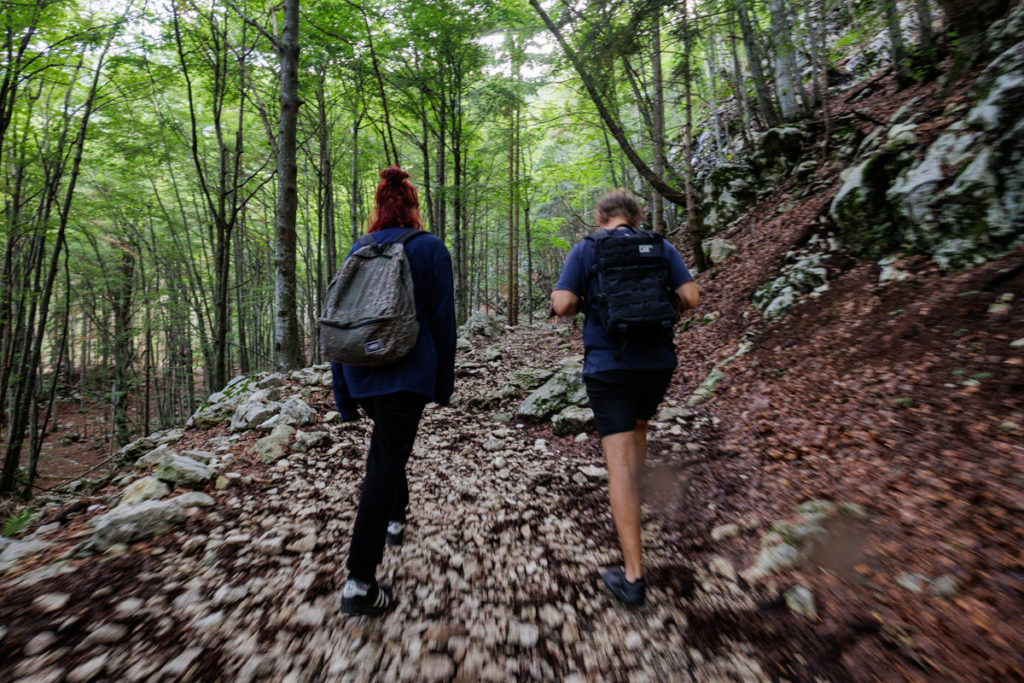
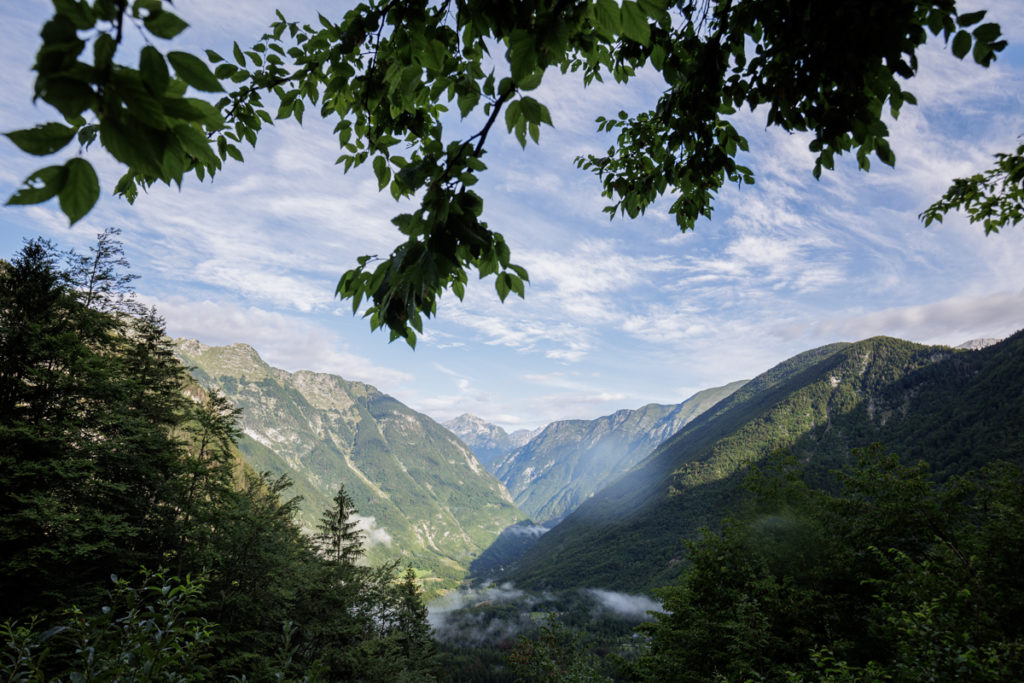
Your reporter was helping with preparations for the PIFconcert at the Fort Kluže on Wednesday, so she was unable to attend the hike. Luckily, PIFlars are just one step away at all times. We talked to Oriol, who enjoys going to the mountains, and he was very pleased with the trip. The group walked the not-too-difficult route from the Klement Jug mountain lodge in Lepena to the lake in just over two hours, before taking in the view of the beautiful Krn Lake, stopping for a coffee in the mountain lodge and signing the visitors’ book. The return journey took a little longer, but our mountaineers still managed to reach the base PIFcamp in time for lunch.
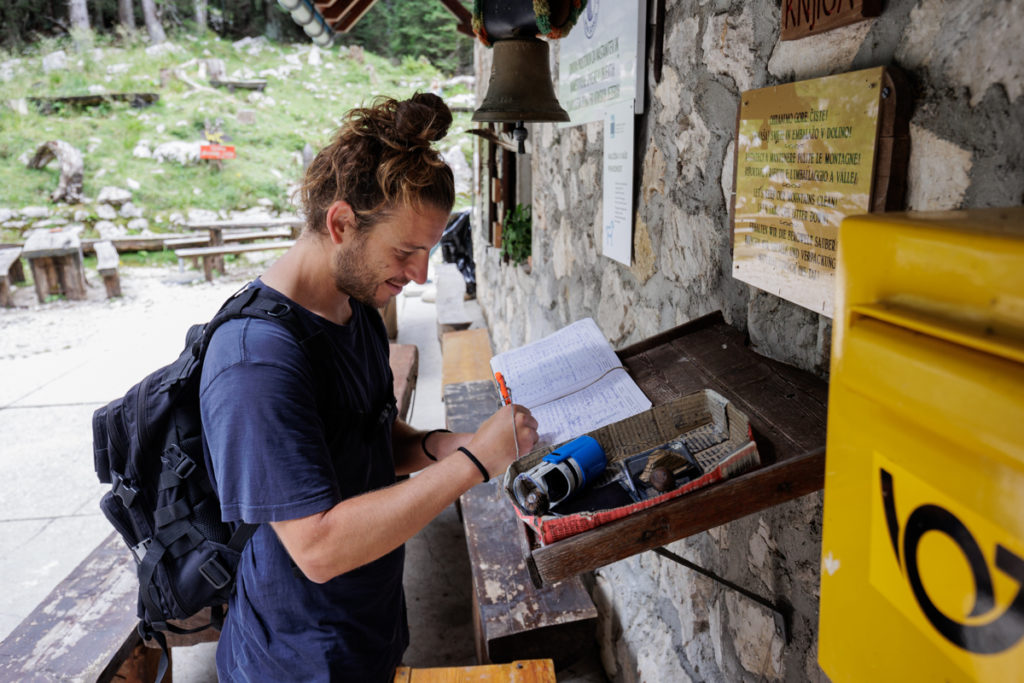
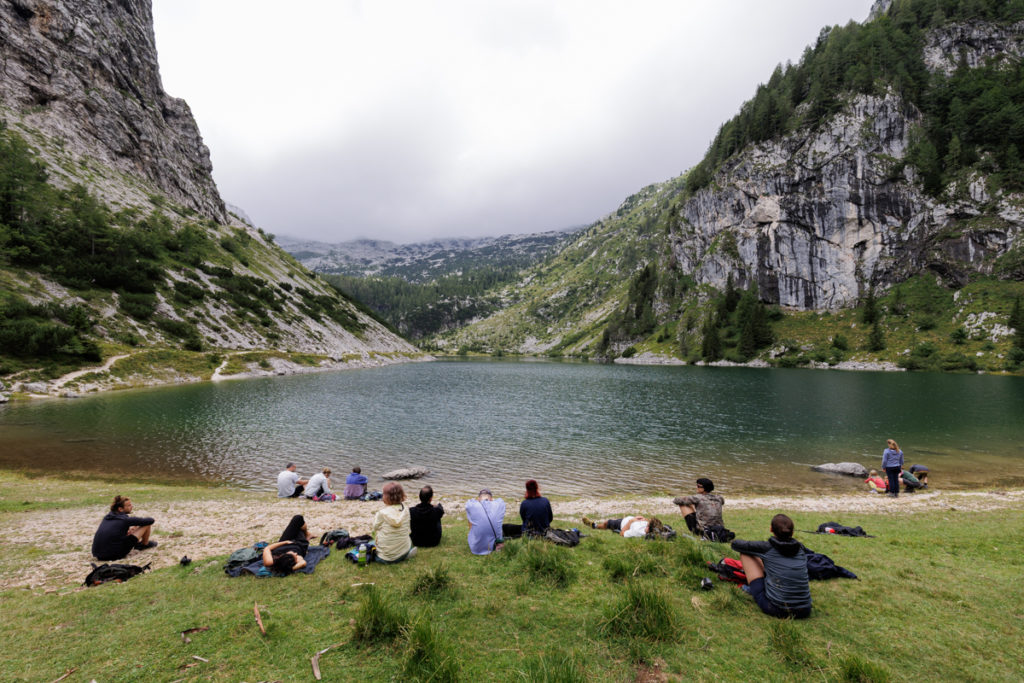
On the initiative of Jani Pirnat, another PIFcamp familiar, part of the organizing team decided to move one of the numerous jam sessions, which take place on the PIFterrace, to the walls of the walled courtyard of the Fort Kluže. The event, held under the title PIFconcert and Algorave: Lasers, beeping and lightning, featured no less than 14 performers. The majority of the audience was made up of PIFcamp participants, but we also noticed a few dozen external visitors. The courtyard of the Fortress is a beautiful venue, but this was not the reason why the event was a success. We should thank the wonderful performers right at the beginning of this report, for their music and visuals that transported us to different dimensions.
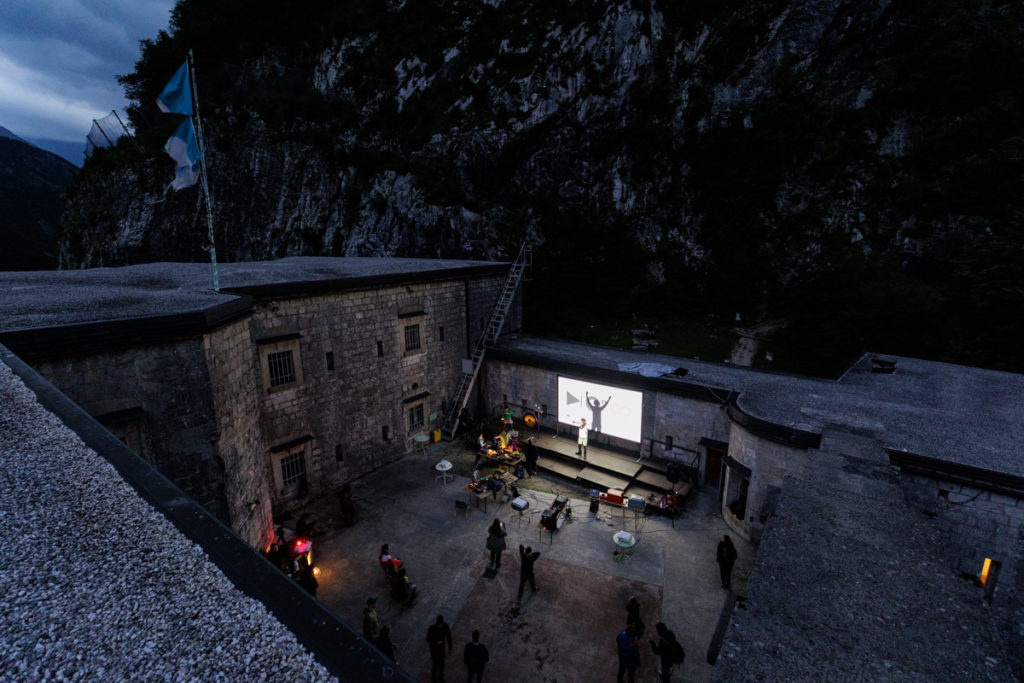
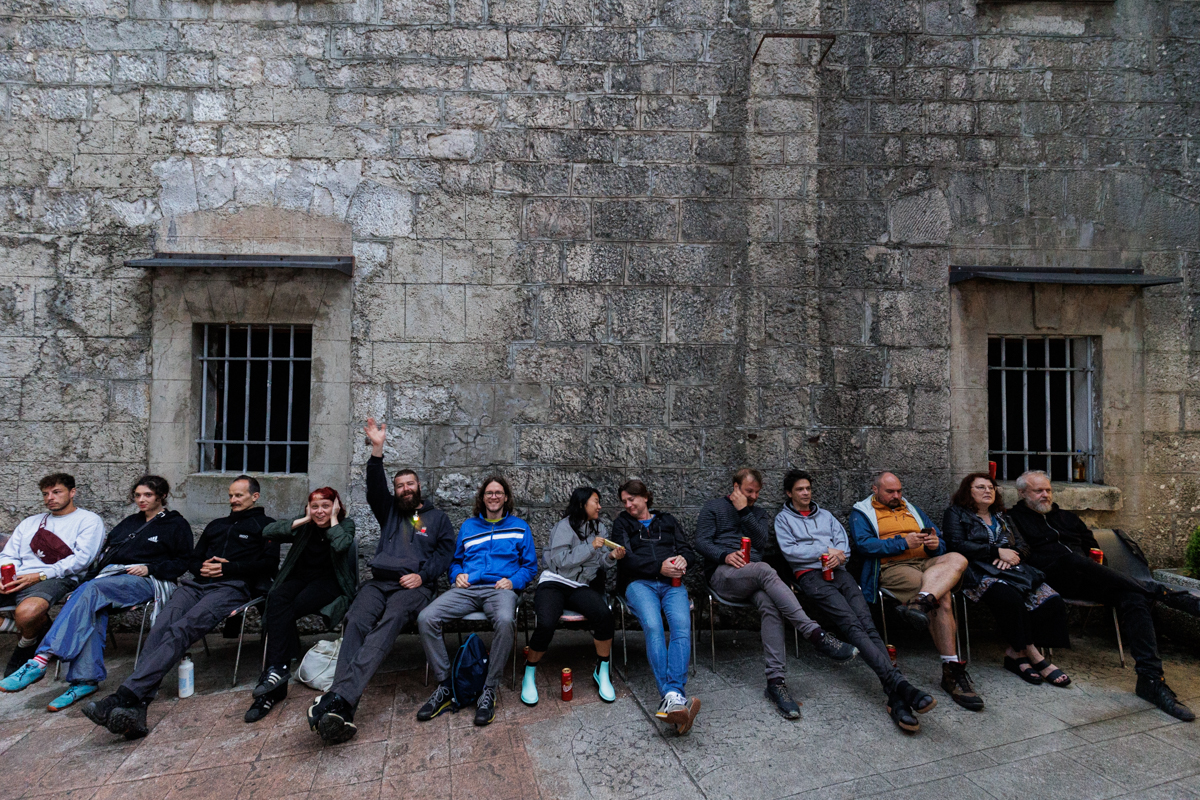
At 9 pm sharp, the stage was taken over by the first first-time trio of performers: multi-instrumentalists Rob Canning and Robbie Hopper were accompanied on live coded visuals in P5LIVE by Julia Múgica (aka Dr. Ju). Another premiere duo featuring Tilen Sepič and Linalab (Lina Bautista) followed with a modular synths-live coding combo. Lina used the Mercury environment for the first time in a public performance, and we must say it didn’t show. Halfway through their performance Hansi3D and Jerobeam Fenderson climbed one of the walls of the fortress and covered the interior walls with multi-colored laser nebulae.
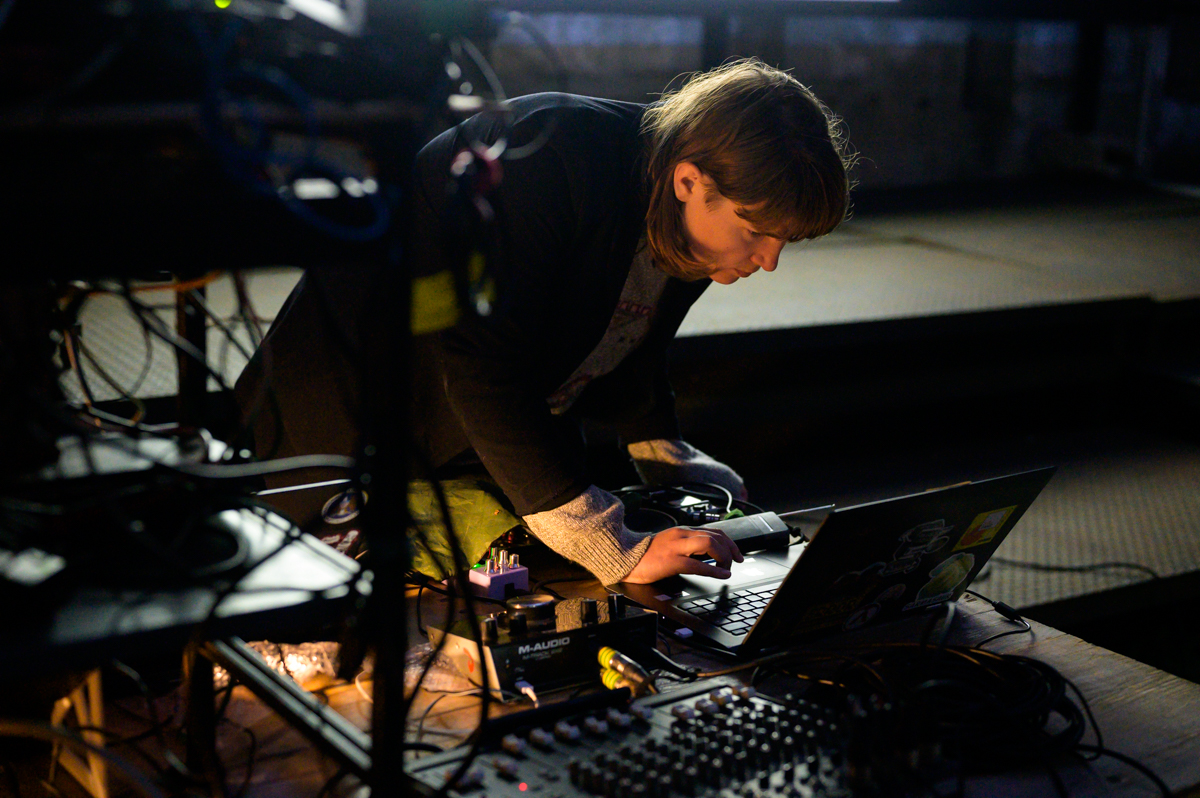
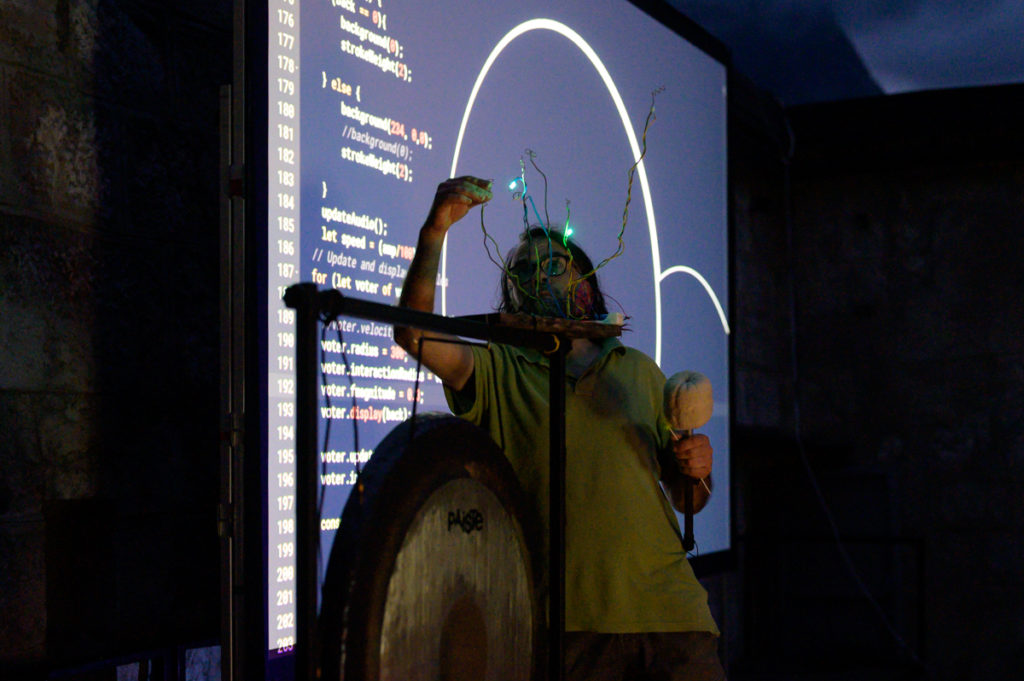
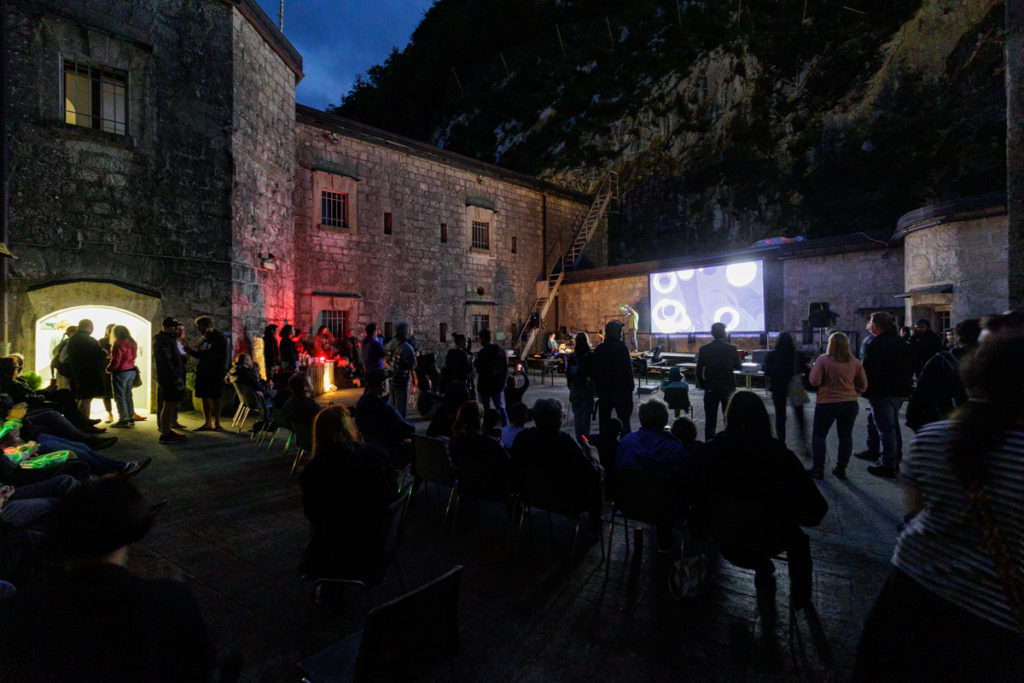
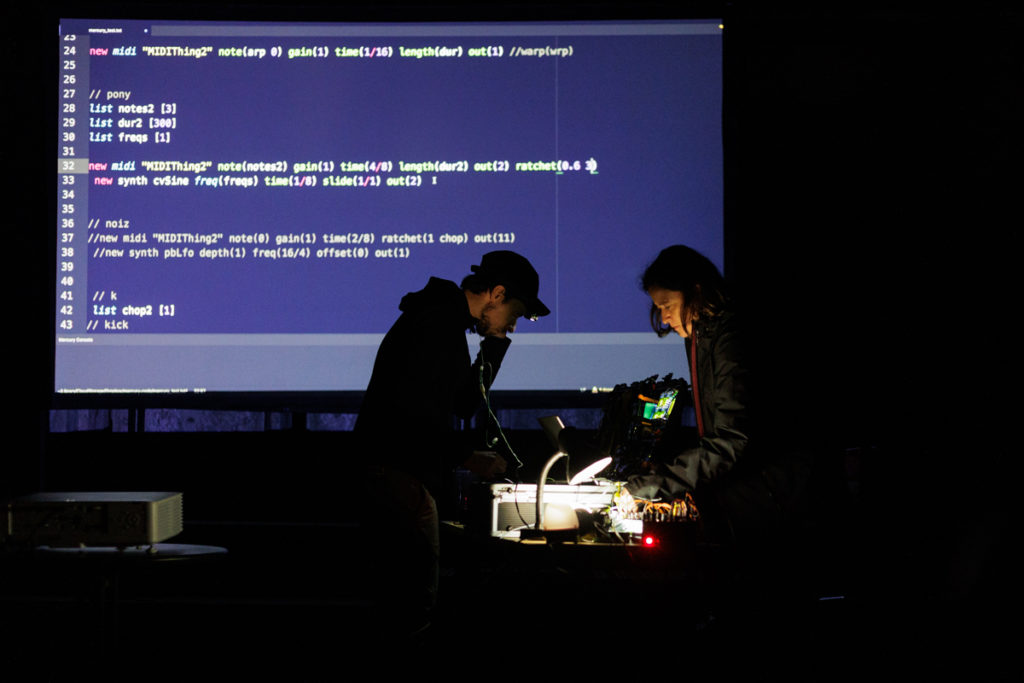

The audience was already well warmed up when Oscilloscope Music turned their lasers in the opposite direction, facing the hill below Fort Hermann. Judging by the gasps, cheers and applause during their AV set, the audience was nevertheless caught off-guard by their dazzling show. One of the participants posted a story on her instagram profile during which we managed to overhear the following priceless comment: “What’s thaaaat?!! I just found myself in 16 dimensions at the same time!”

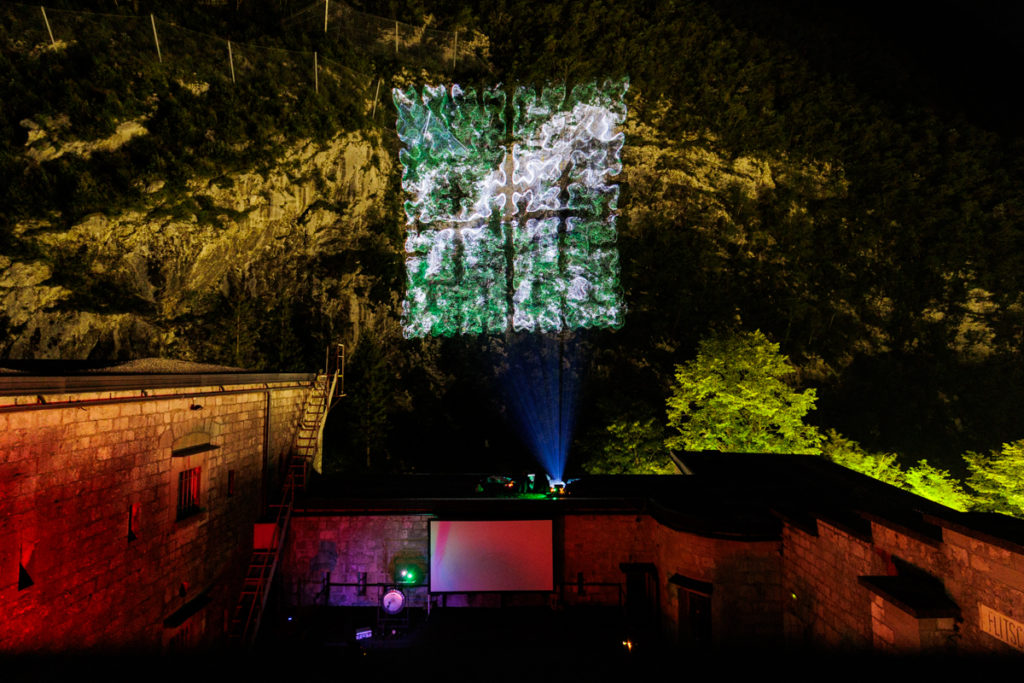
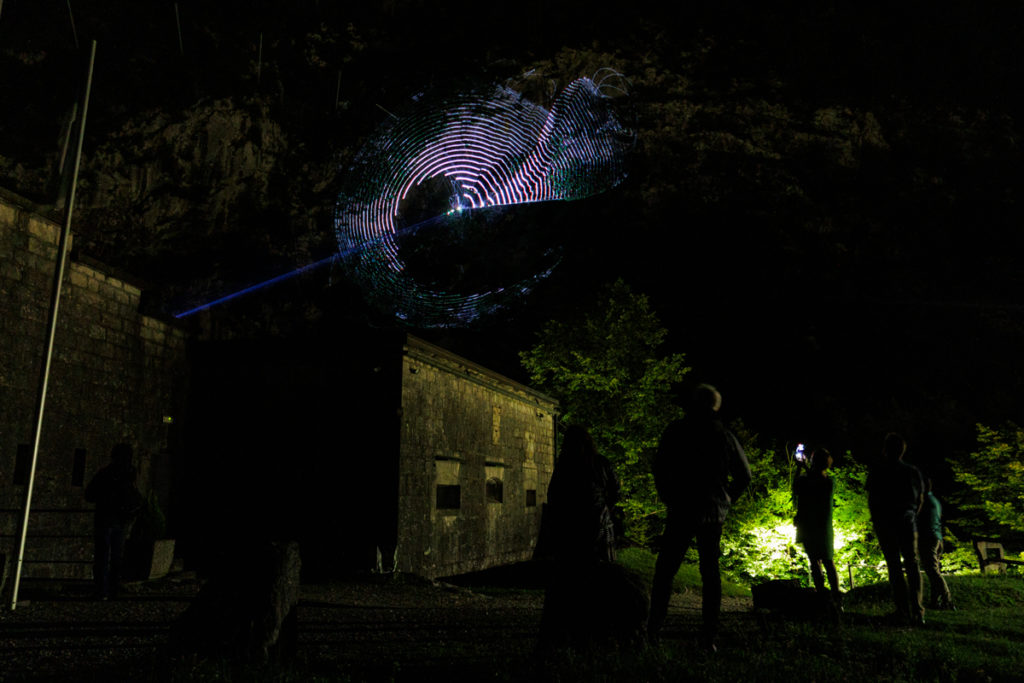
After the dynamic lasers duo, another PIFsupergroup took the stage, this time consisting of Manu Retamero aka ëgg and Tina Tonagel, accompanied by Sophia Bulgakova‘s digital-analogue visual delights. The last two performances were yet another treat for live coding fans: the supertrio of the Toplap Barcelona collective – Iván, Roger and Niklas – showed off their programming and performance skills and, of course, their screens. Iván codes his music in SuperCollider with the assistance of AI, Niklas performs in his own Mégra language, while Roger used Animatron, a 2D animation live coding environment he co-created with Glen Fraser, for the visuals. Laurent, who prepared his AV set in FoxDot, provided the perfect finale with exactly the right amount of rhythms, repetition and melody. Wednesday didn’t exactly provide a traditional end to the day, but a glance at the timetable announced a much more traditional Thursday – workshop on workshop on workshop. A true classic, which of course we will also report on.
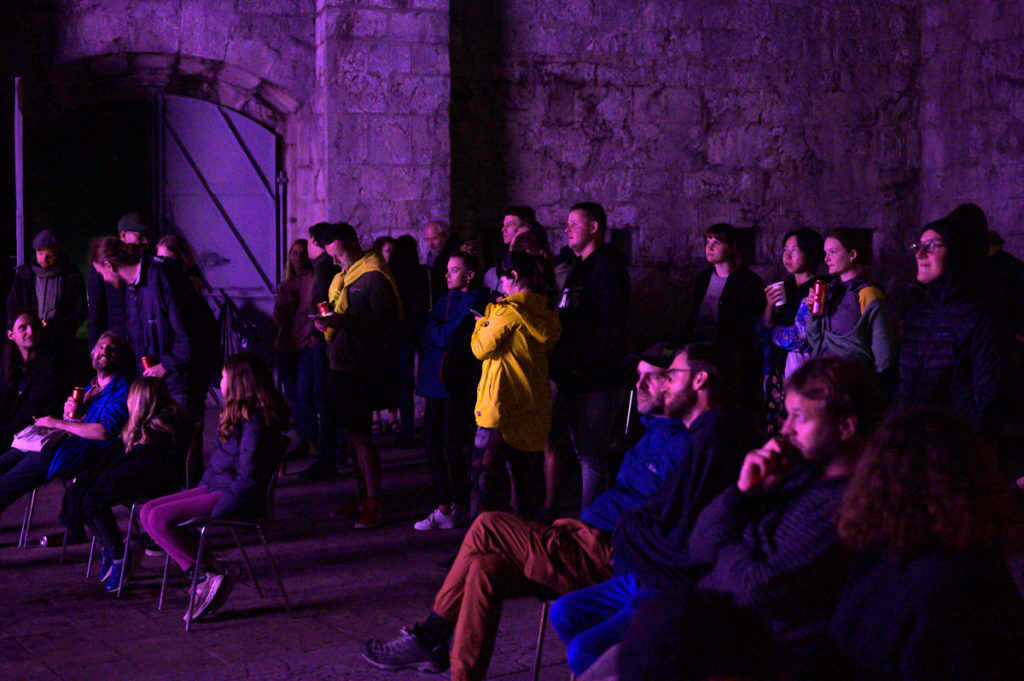
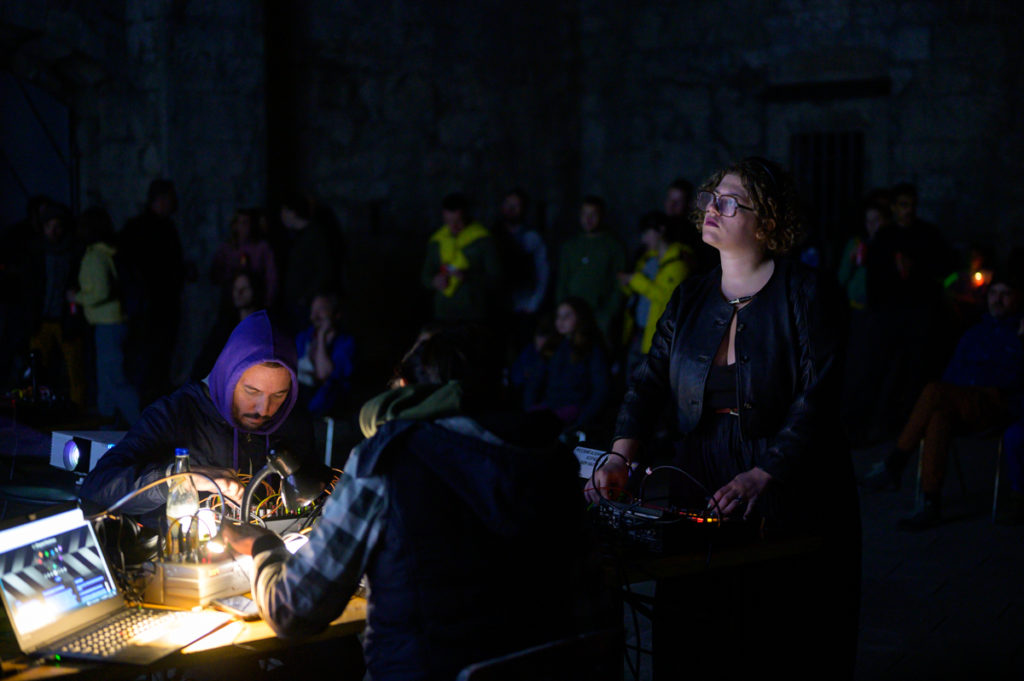
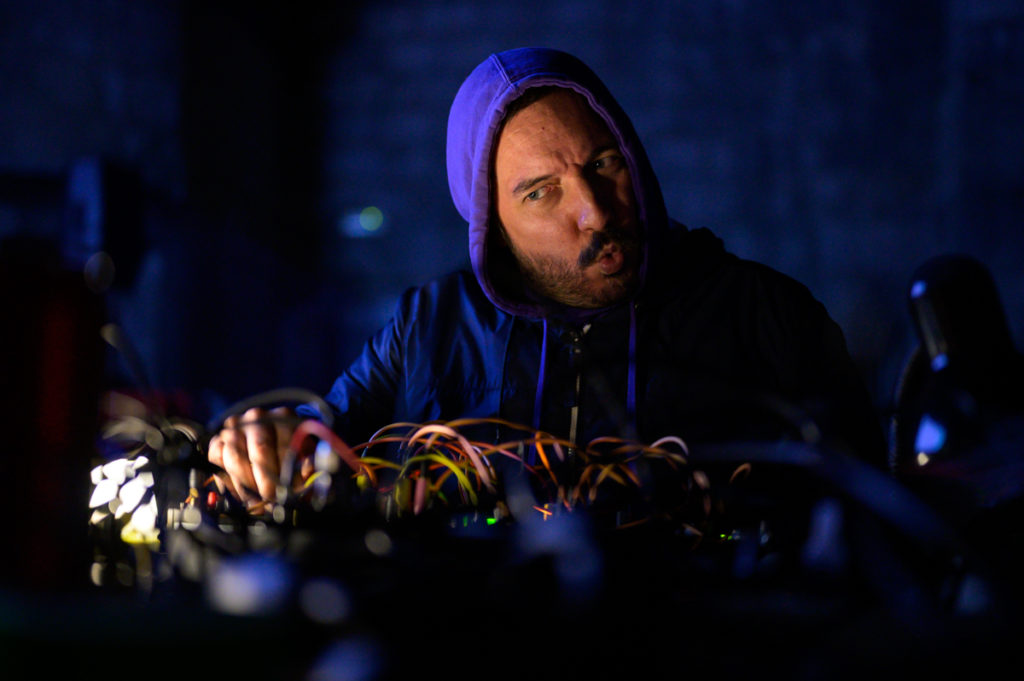
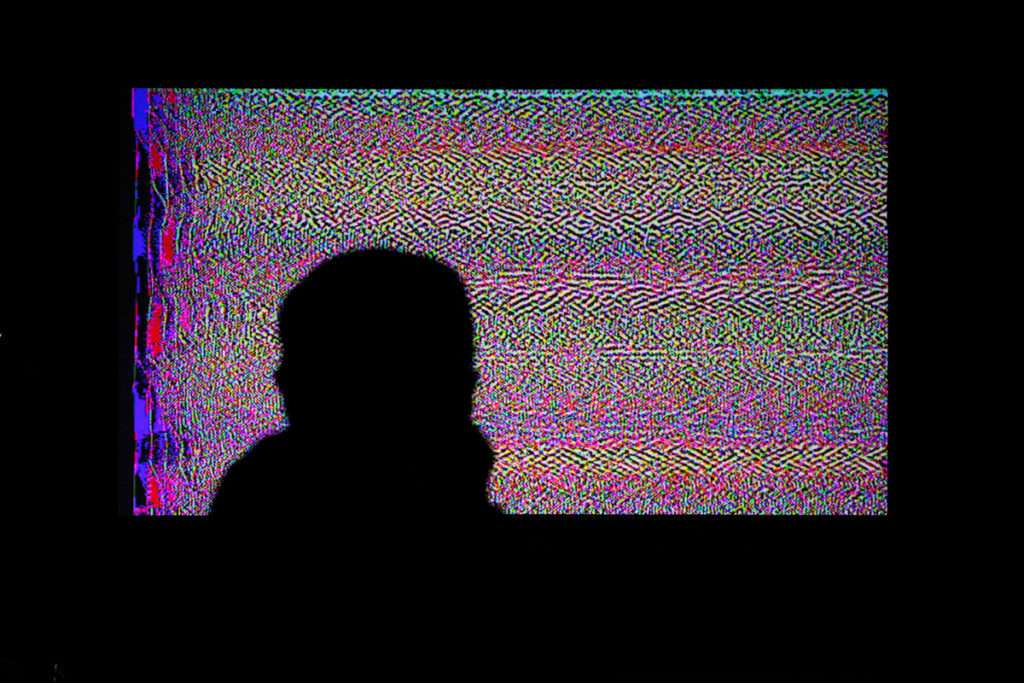


please wait. PIFlog entry coming soon.
Participants woke up to a slow, rainy Tuesday. Grey clouds were hovering over PIFcamp for most of the day, but few raindrops won’t stop PIFlars, maybe just slow them down a bit. In the morning, the kimchi-making workshop, led by Maya Minder, retreated to Neža’s kitchen. We will report on the results on Saturday, when the fermented delicacy will be ready for tasting.
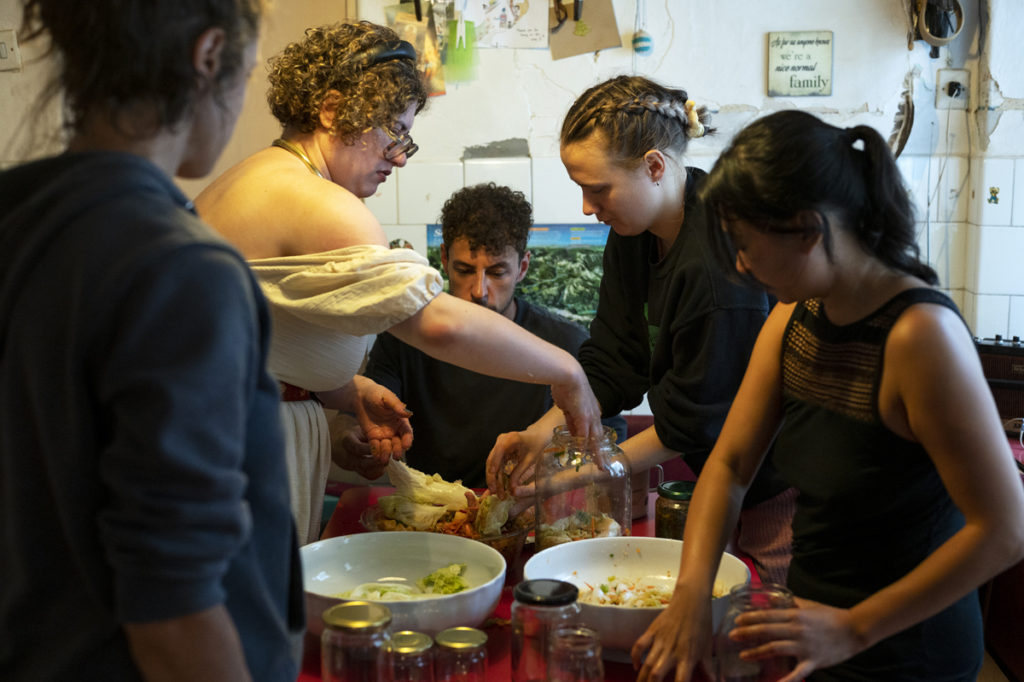
After lunch, Alicia Champlin and Julia Múgica invited the participants for a heart rate monitor building workshop. Their wearable device uses an EPS32 microcontroller that sends the data of the heart rate sensor over WiFi. Alicia and Julia will then sonify the data and make a sound piece for a multi-channel setup. Their initial plan was to present it in the dome, but we’re sorry to say the weather conditions don’t seem to be ideal for that.
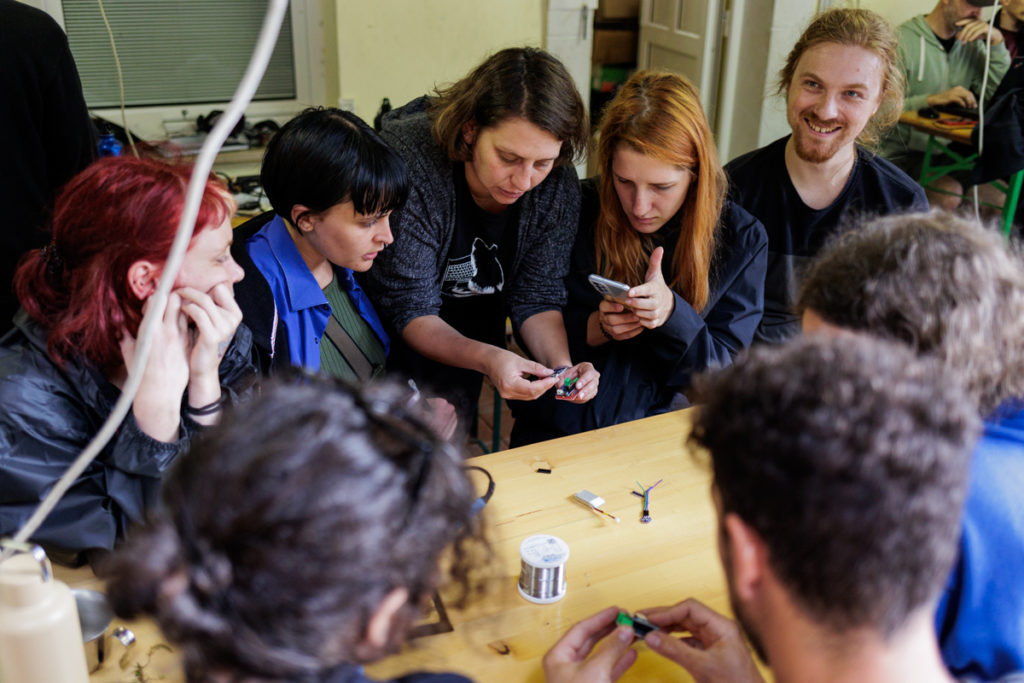
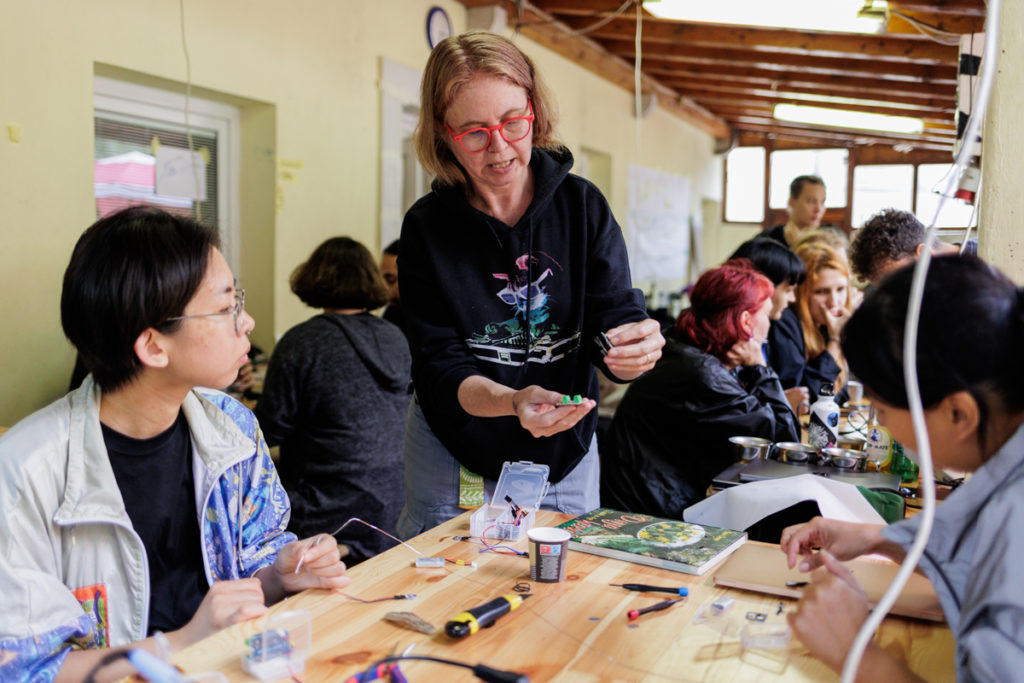
This year’s PIFresident, Michael Candy, who enjoys making nonsensical devices, presented his drone, on which he sometimes mounts a mobile phone with videos he has taken in other locations. Because he can. Michael is also an avid robot builder, so stay tuned for more info on his PIFprojects.
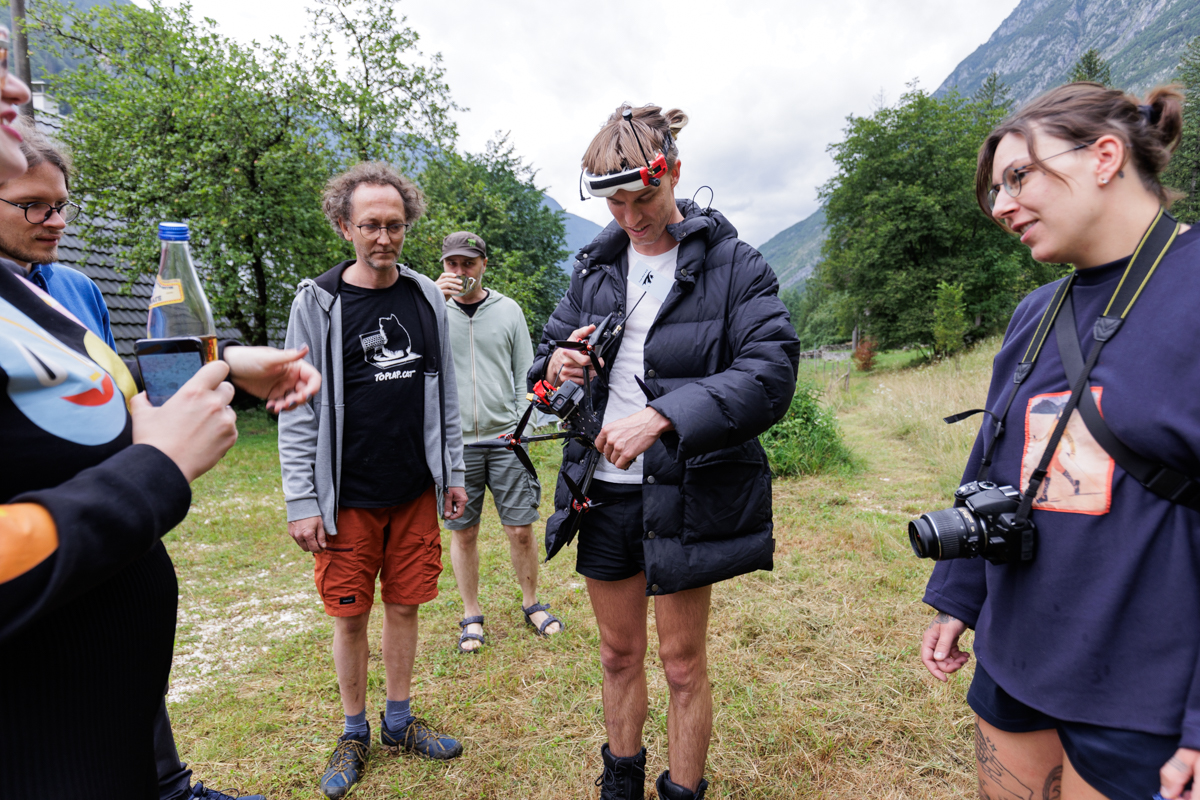

Rob Canning and his daughter Meta have been preparing for Thursday’s Networked Touch workshops, which will provide participants with a choice of three levels of complexity – from an LED brooch to a musical instrument that can be played by touching wires. Apart from building various devices, some PIFparticipants were also hard at work laying bricks. Meet Martin Mušič (on the photo below Rob) who works with clay and porcelain. He already invited fellow participants to get their hands dirty and try different types of clay for modelling objects. One of his PIFprojects also includes building a DIY clay burning oven to be used by the end of the week.
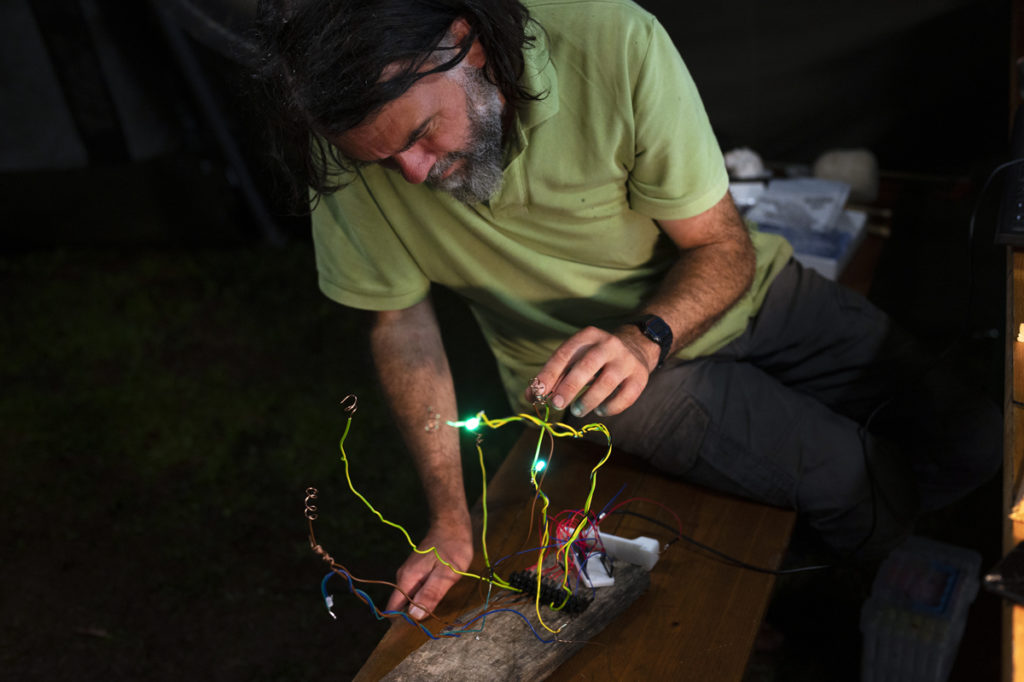

The last Tuesday workshop was delivered by Rodolfo Acosta Castro, who enthused the participants with bat calls, echolocation, and bat detection devices. His own design, a bat detection device which translates the ultrasound frequencies to lower frequencies, audible to humans, really impressed the audience. Rodolfo prepared the materials for the participants, so they can build the devices themselves – apart from the receiver, he also designed a synth for reproducing bat calls. The most enthusiastic PIFlars started soldering right away, while the majority of the workshop participants just assembled the kits and made plans to start building in the following days. Of course, you’ll be the first to know when they succeed.
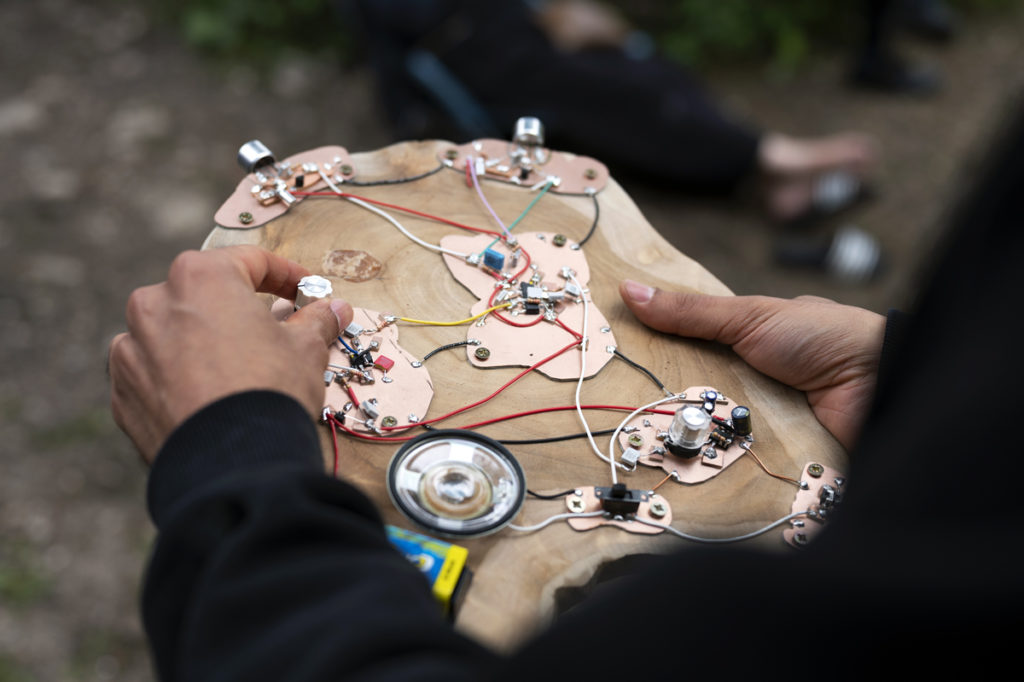
Monday’s jam under the canopy was taken over by the live coders, while Tuesday saw the return of the synth (and apparently feedback loops) enthusiasts. Sophia and Laurent did the visuals with a digital-analogue setup, while Manu and Tina played with synths and no input mixers. Their rich textures swayed participants into the night…
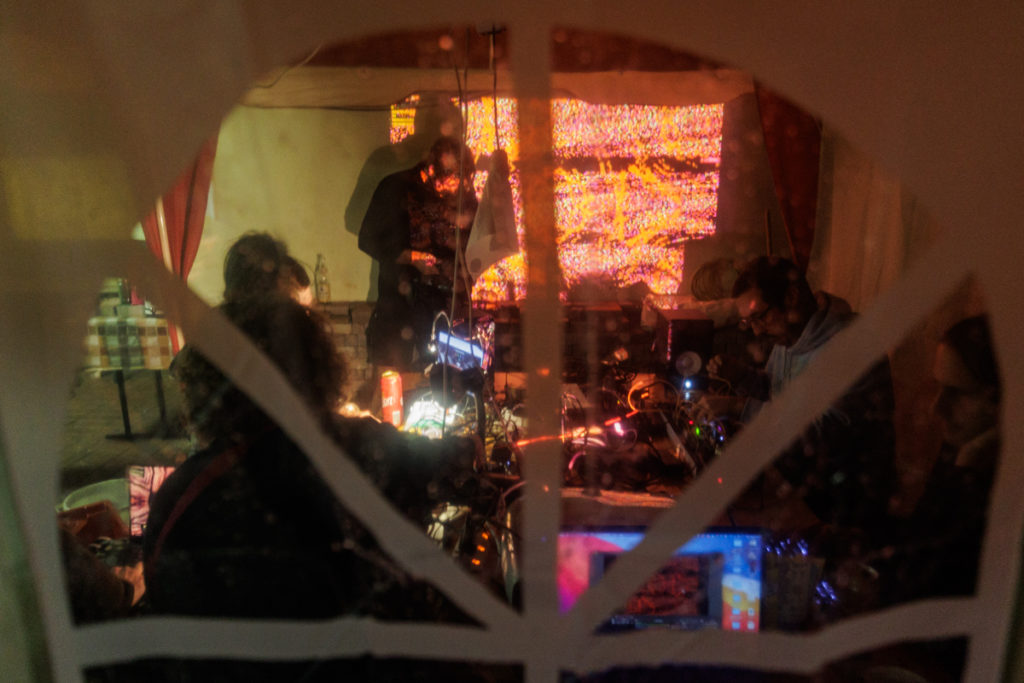
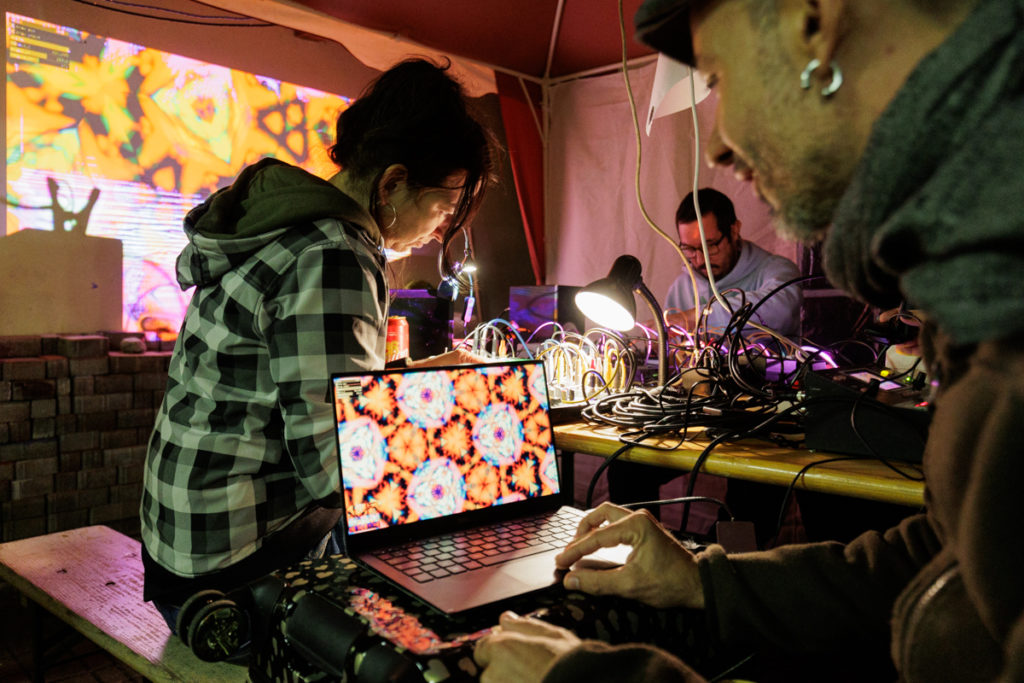
In PIFtopia, the work week doesn’t really start until Monday (not unlike other parts of the world). Participants mostly spent it planning, exploring and getting to know their surroundings. After breakfast, a group of PIFparticipants joined Ewen for a walk and the launch (or rather: lifting) of his solar balloon. Other PIFlars spent the morning getting attuned and exploring the PIFcamp’s surroundings, but after lunch (and coffee!), the grounds slowly started to resemble a real work site.
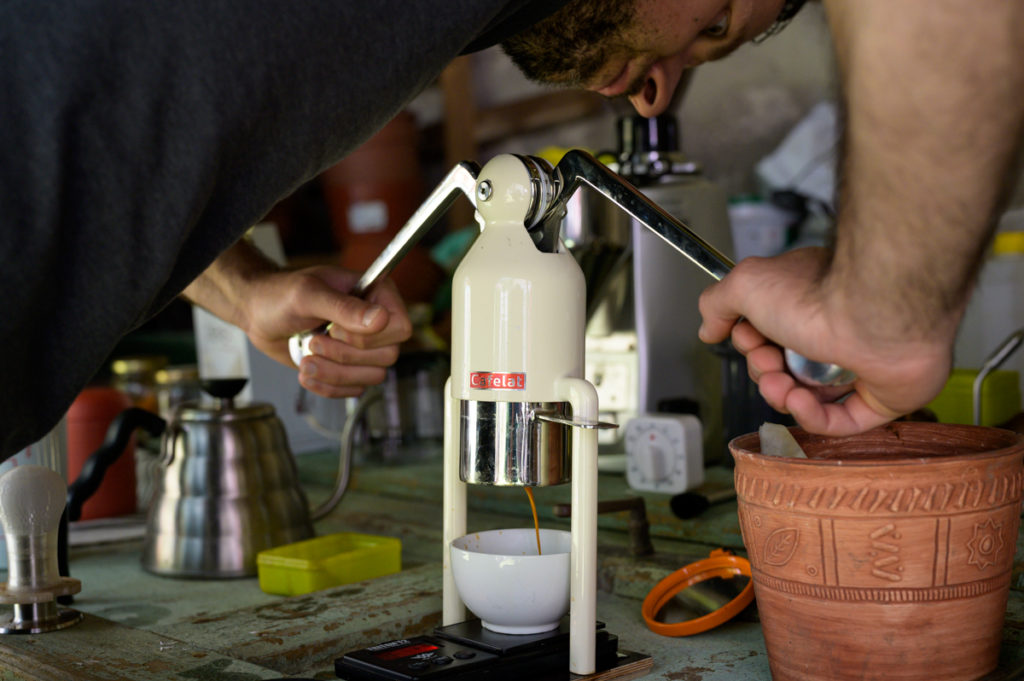
In the afternoon, a group of performers and organizers of the PIFconcert and Algorave at the Fort Kluže set off for a visit to the venue, while wild food enthusiasts went for a walk with our neighbour Neža to Lamovje, where they explored the edible plants and mushrooms growing in the area. We will report on the foraging expedition and other food-related activities in a special PIFood feature. In the meantime, the base camp hosted some workshops. At 4:20, Maggie Kane organized a PIFjournaling workshop under the canopy, and Nejc Trampuž gathered a group of curious PIFparticipants under the tent for an intro presentation on creating animations with AI.
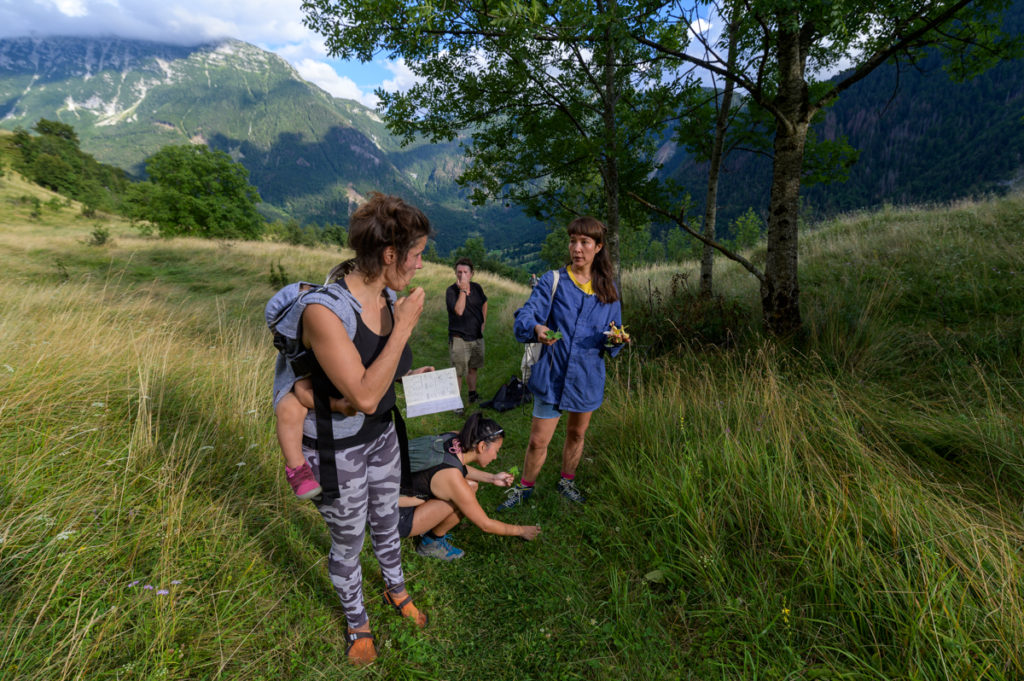
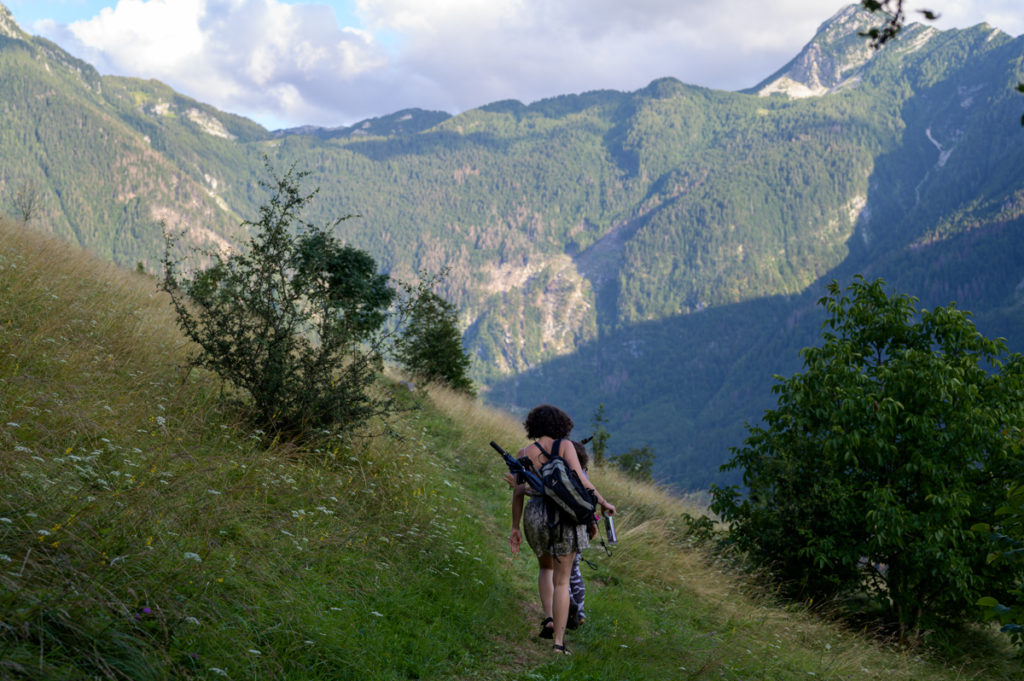
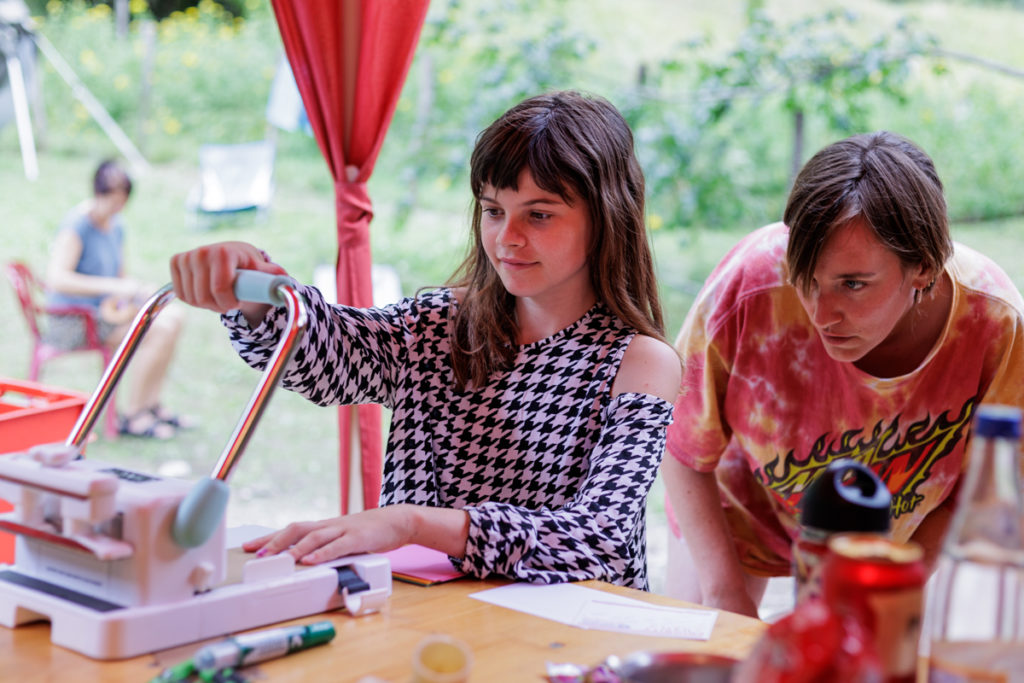
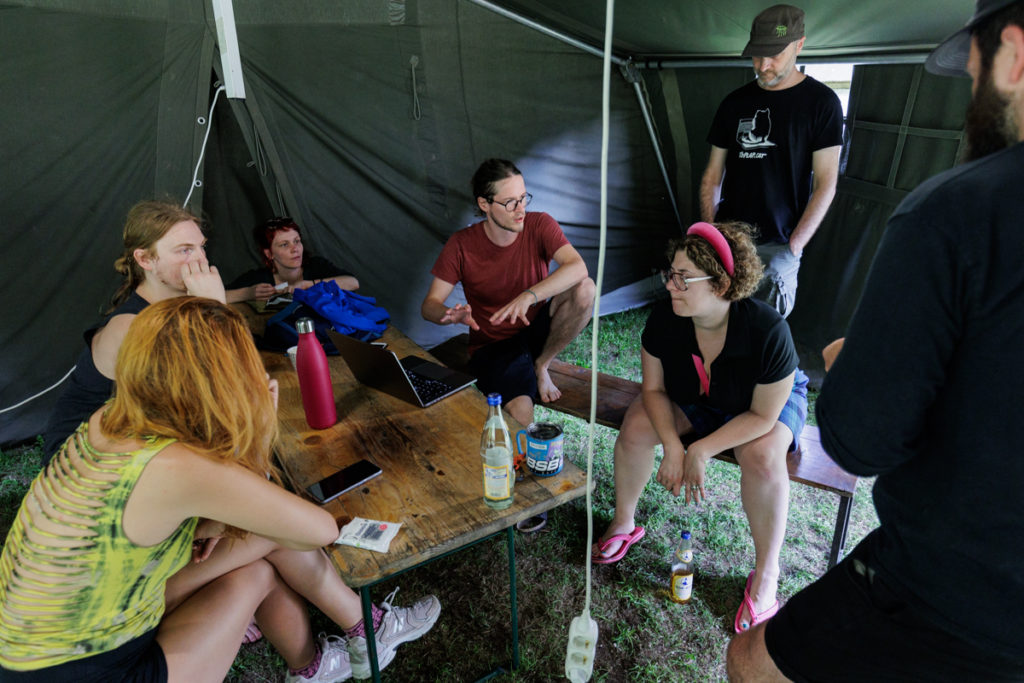
Preparations are also well underway for the projects in the Immersive Sound Dome. Lan Wu is one of the participants who will be presenting his work in the dome, a sound piece featuring field recordings. In the afternoon, he invited the field recording enthusiasts for a test walk and preliminary recordings of the sounds around Soča river.

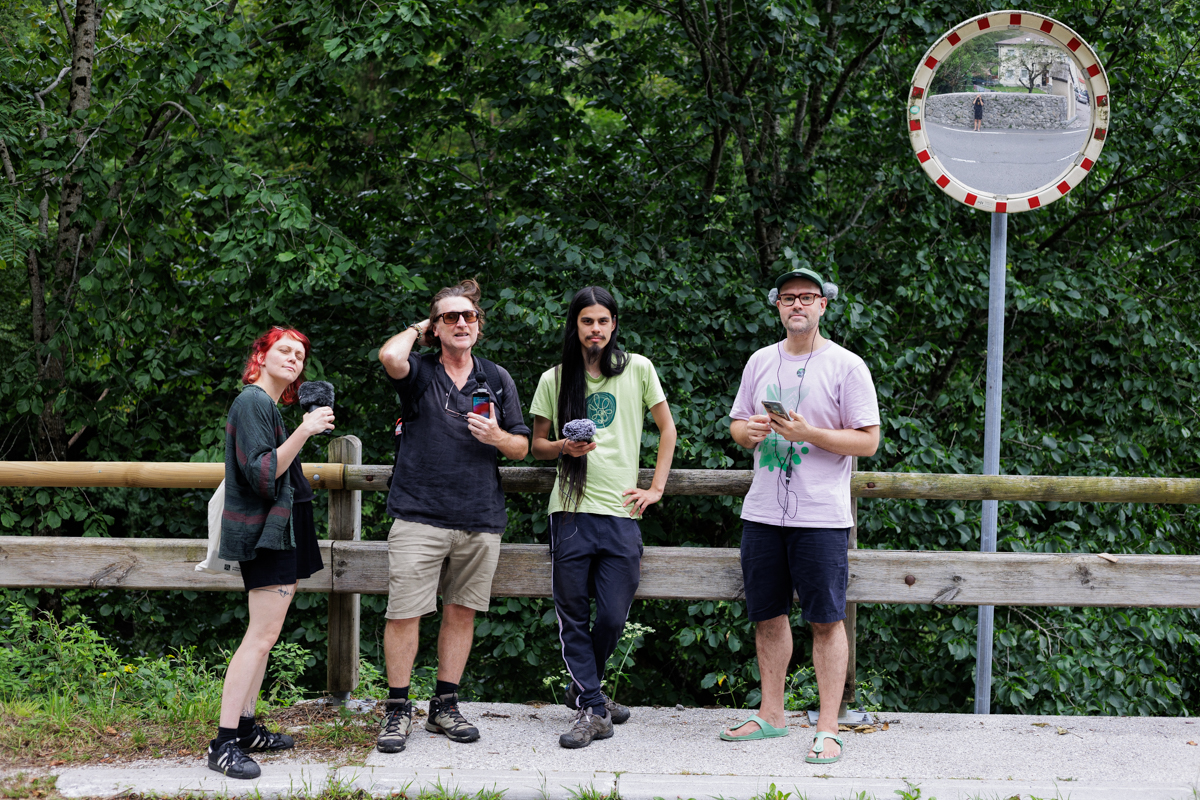
Monday ended with a bonfire, live coding and lasers projected onto a nearby tree by Hansi and Jerobeam (aka Oscilloscope Music). Despite copious amounts of coffee and clubbing beverages, your reporter is a bit slowed down due to low air pressure, but you can expect a more comprehensive report on the PIFprojects tomorrow.
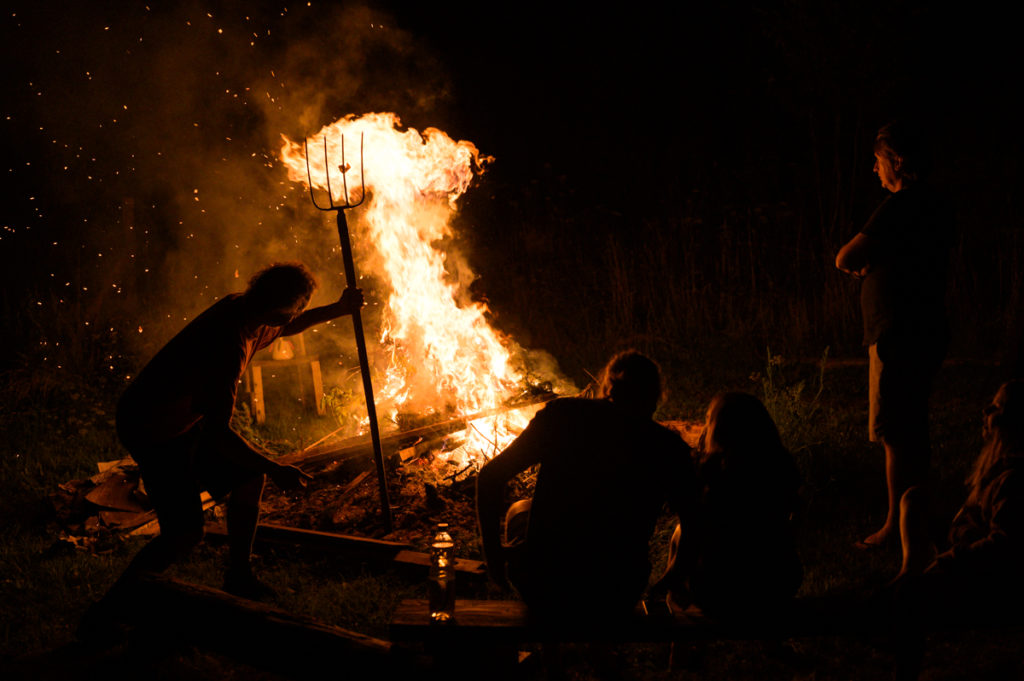
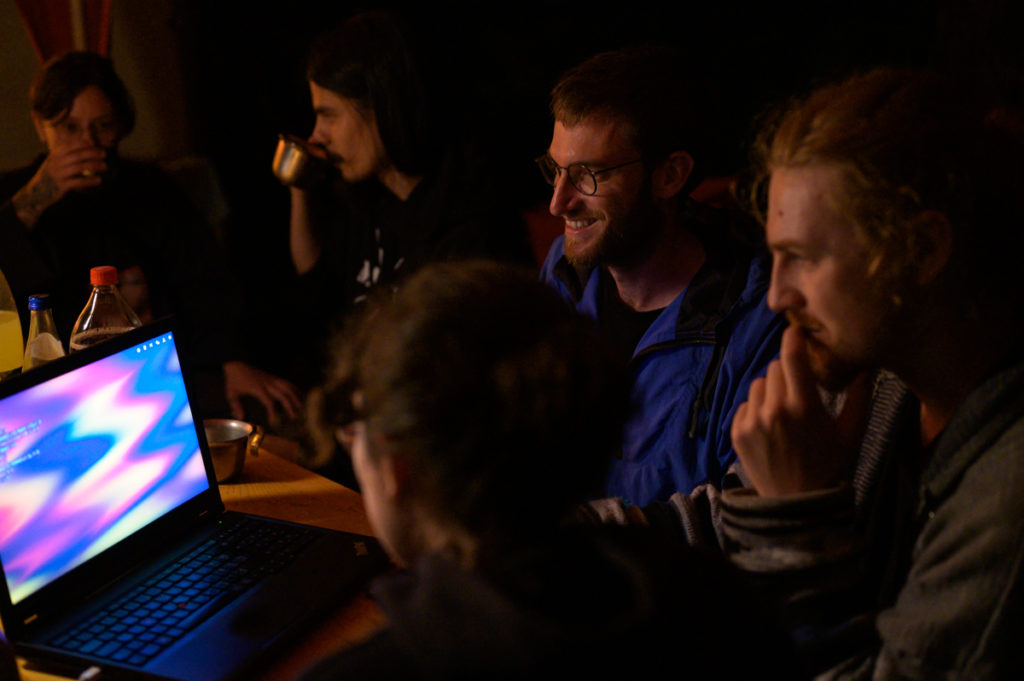
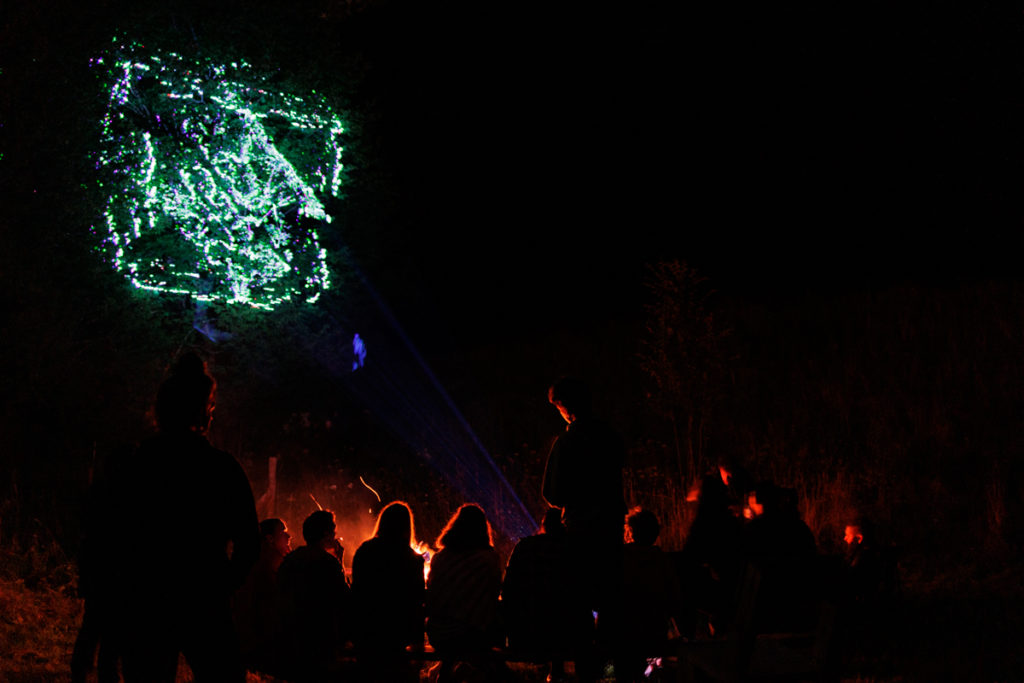
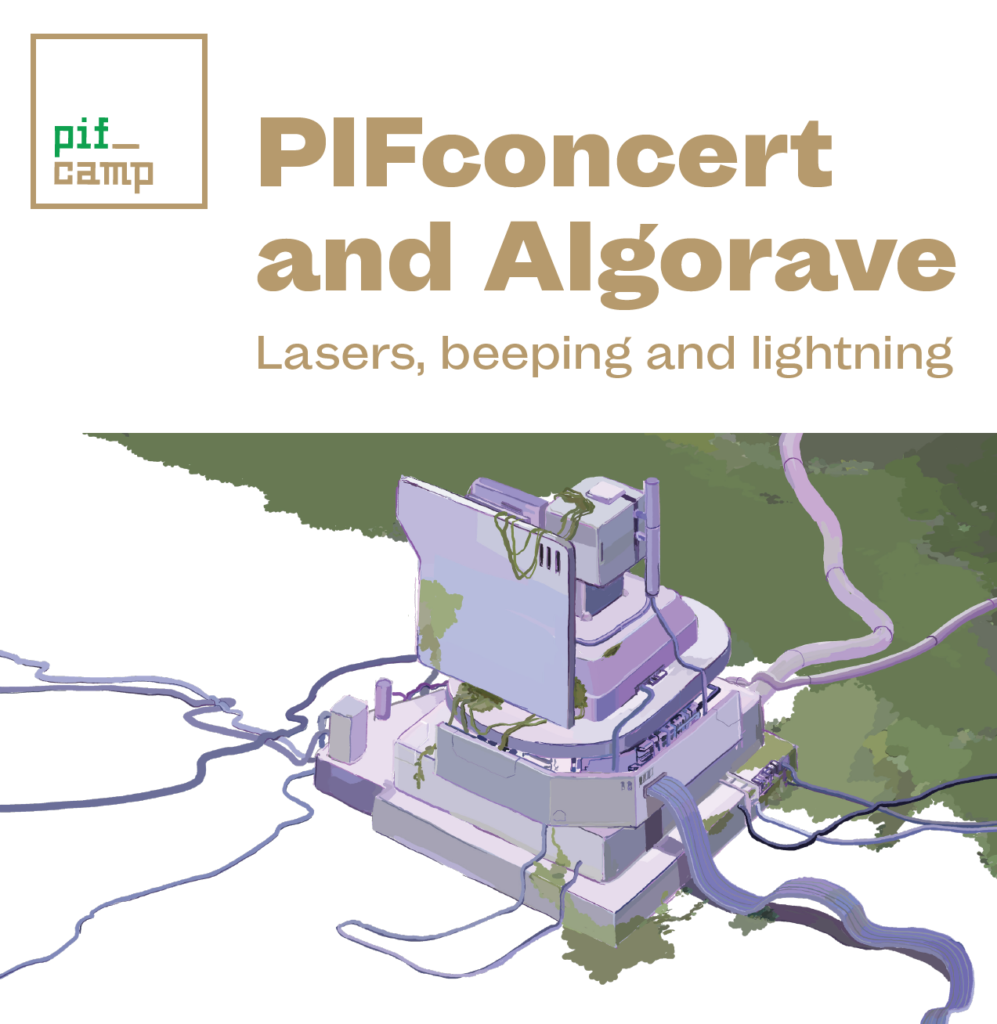
If you are wandering around Bovec and its surroundings on Wednesday 2 August, make sure to visit Fort Kluže in the evening. PIFparticipants will pull out their synthesizers, oscilloscopes, projectors and laptops for an evening of lasers, beeping and lightning between 9pm and 11pm.
Lineup:
(づ ◕‿◕ )づ Rob Canning & Robbie Hopper (+ Julia Múgica)
(づ ◕‿◕ )づ Linalab & Tilen Sepič (+ Oscilloscope Music)
(づ ◕‿◕ )づ Oscilloscope Music AV
(づ ◕‿◕ )づ ëgg & Tina Tonagel (+ Sophia Bulgakova)
(づ ◕‿◕ )づ Niklas Reppel & Iván Paz (+ Roger Pibernat)
(づ ◕‿◕ )づ Laurent Malys AV
Free entry.
In case of thunderstorms the event will be cancelled.
What will you read about on this year’s PIFlog? After the introductory presentations, we can predict that you will once again enhance your knowledge about live coding, witness the return of fermentation and foraging enthusiasts and immerse yourself in the surroundings of the village of Soča with all your senses. Once again, synths, lasers and all sorts of robots will abound. The worksite is ready, let’s get to work!

Along with many of the live coders you’ve already met on this blog, this year’s participants also feature a few newcomers. Laurent Malys is attending PIFcamp for the first time this year, and this week he will continue working on his performance Body to Code, which combines dance and live coding. Ironic and impractical, his transhumanist performance showcases the creativity of algorithmic electronic music while questioning the interconnections between humans and machines.
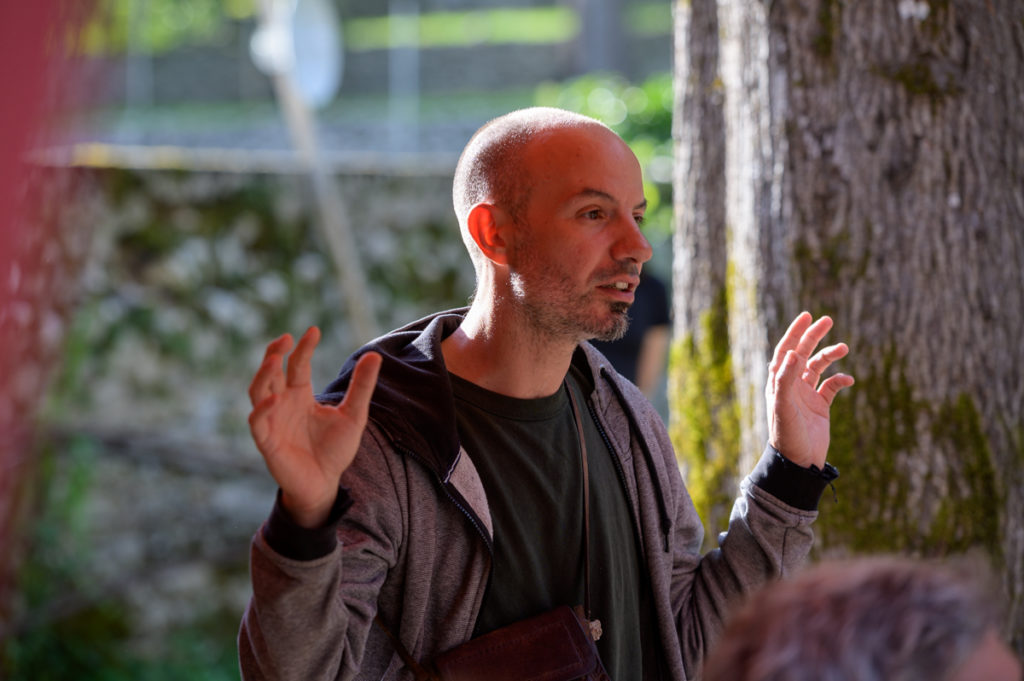
Laurent during his PIFproject presentation. Photo: Katja Goljat
Niklas Reppel, one of the PIFcamp returnees and members of the Toplap Barcelona collective, often combines live coding with field recordings in his practice. This year, he will populate the surroundings of PIFcamp with various objects on which he is placing binaural microphones (in the shape of human ears) to explore how the world around us sounds from a non-human perspective. The project is dedicated to the memory of composer and sound artist Alvin Lucier.

Blaž Pavlica, an old PIFcamp familiar, is back with his DIY sound dome project, which he has upgraded in every way this year – in addition to a brand new lightweight structure that makes assembly easier, the immersive sound dome now includes a 16-speaker system, with a canopy floating above it to protect it from the rain. The dome soundscape will be co-created by a number of PIFlars, and we’ll make sure to report on their projects in the coming days.
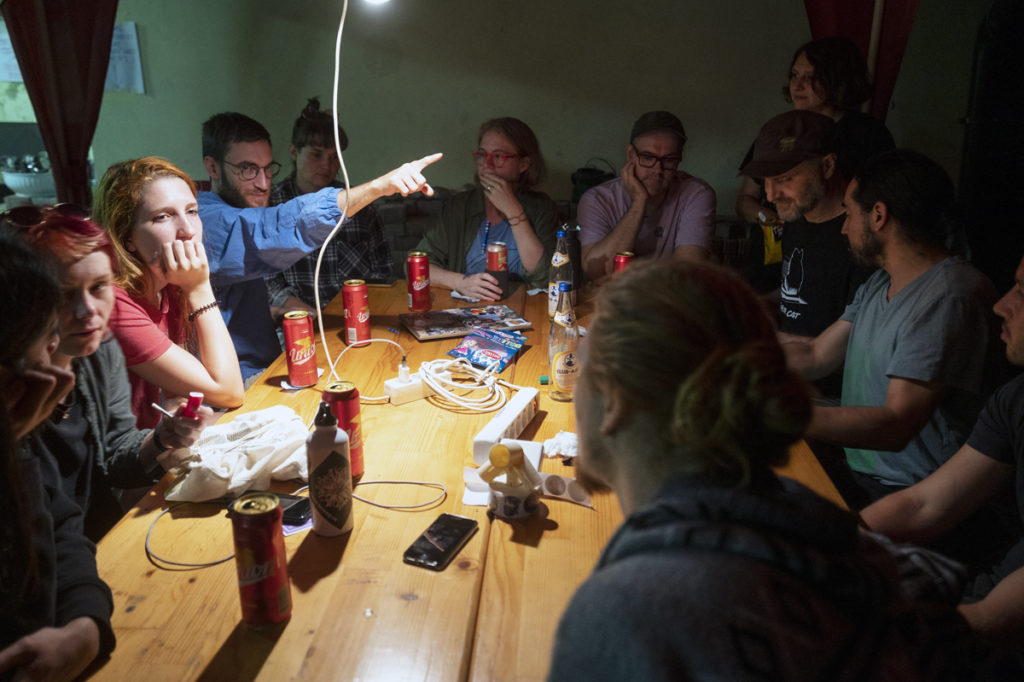
Dome projects planning with Blaž, its navigator. Photo: Katja Goljat
In addition to the writers of your favourite PIFlog, reporters for Makery and other documentarists are present at PIFcamp grounds. Live coder and illustrator Roger Pibernat, who was one of the more active participants last year, will be creating a visual diary for the aforementioned portal at this year’s PIFcamp. We can’t wait to see the results!
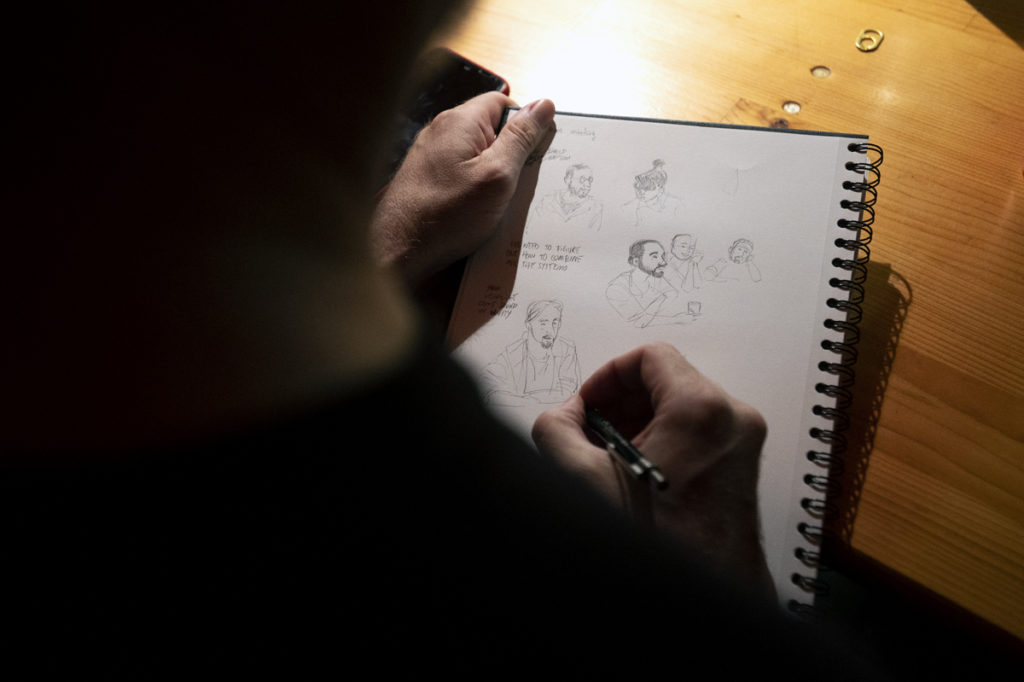
A sneak peak into Roger’s sketchbook. Photo: Katja Goljat
We end this introductory roundup of some of the projects with one of our favourite recurring PIFprojects – for the fifth year in a row, Klemen Košir has been researching ways to feed more than 60 hungry PIFlars. So far, it looks like he’s going to succeed yet again. Tomorrow we will report on the first workshops and the progress of the remaining projects, so stay tuned!
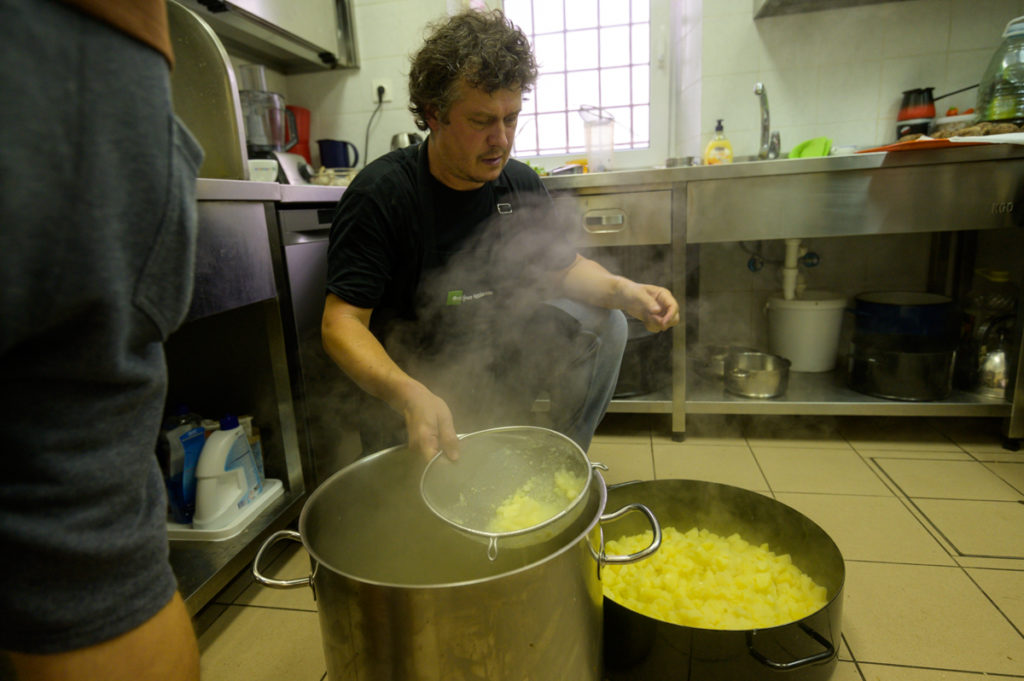
PIFlars flocked to the Soča Valley from all directions to occupy the traditional PIFcamp venue for the ninth time in a row. After the official welcome speeches and a “no-no” (aka you don’t want to try this) list walk-through, more than 60 participants presented themselves and their PIFproject ideas. For the most reliable information on the progress of this year’s projects (and other PIFtopia activities and festivities) follow our PIFlog. We also kindly invite you to visit (and re-visit) the newly established blog on everything PIF and food related, PIFood, and the greatest Instagram meme account in the whole of upper Soča Valley, @pifmemes. Let the PIFtopia begin!
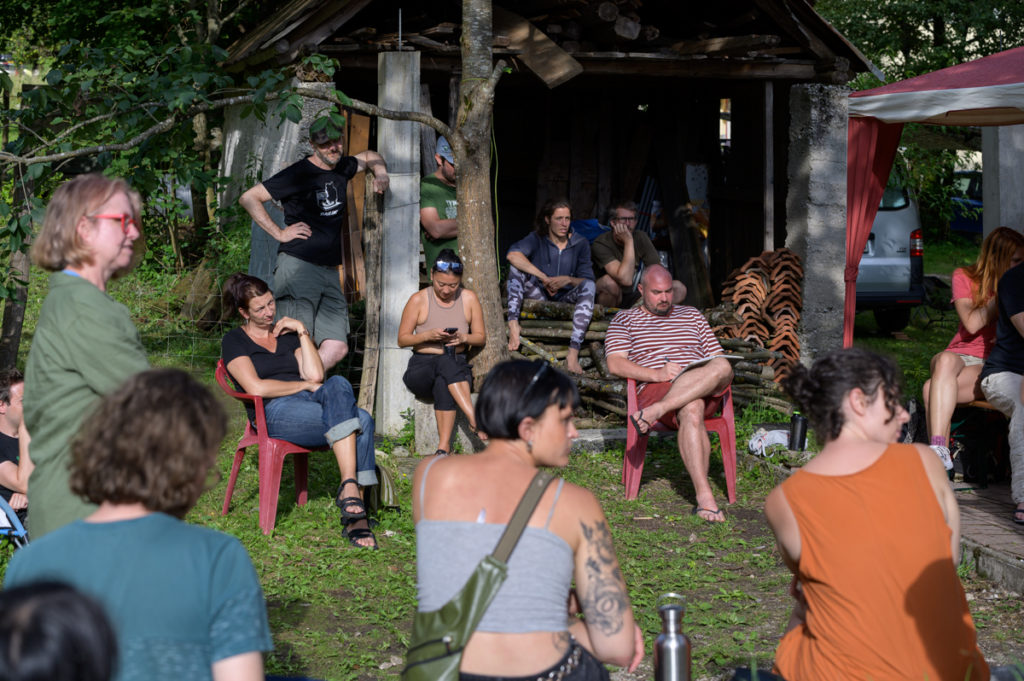
Wednesday, August 2 2023
Fort Kluže, Bovec
from 9 pm to 11 pm
—
Lasers, beeping and lightning
PIFcamp international hacker camp participants are putting on an evening of electronic music and visuals in the courtyard of the Fort Kluže.
Performers: Rob Canning, ëgg, Robbie Hopper, Linalab, Julia Múgica, Oscilloscope Music, Iván Paz, Roger Pibernat, Niklas Reppel, Tilen Sepič, Tina Tonagel
Free entry.
In case of thunderstorms the event will be cancelled.
—
Technical support: GT22, MKC Maribor and konS Platform
Thanks: Soča Valley Tourist Board
Photo: Simão Bessa